Deep Mixing and Metallicity Carbon Depletion in Globular Cluster Giants
等静压石墨 英文原版书籍
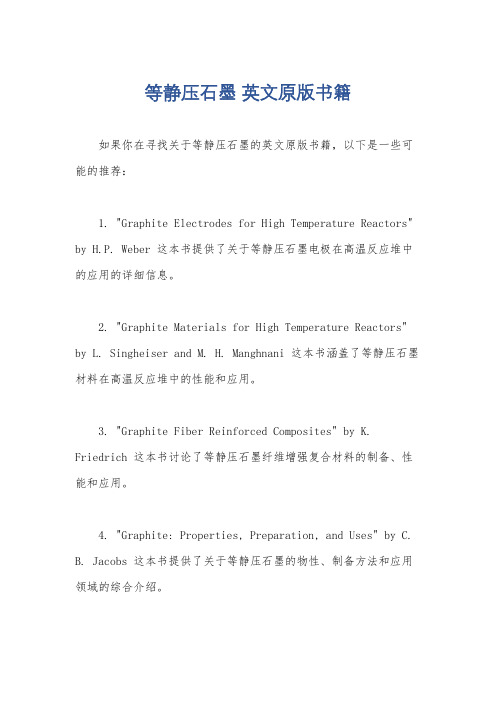
等静压石墨英文原版书籍
如果你在寻找关于等静压石墨的英文原版书籍,以下是一些可能的推荐:
1. "Graphite Electrodes for High Temperature Reactors" by H.P. Weber 这本书提供了关于等静压石墨电极在高温反应堆中的应用的详细信息。
2. "Graphite Materials for High Temperature Reactors" by L. Singheiser and M. H. Manghnani 这本书涵盖了等静压石墨材料在高温反应堆中的性能和应用。
3. "Graphite Fiber Reinforced Composites" by K. Friedrich 这本书讨论了等静压石墨纤维增强复合材料的制备、性能和应用。
4. "Graphite: Properties, Preparation, and Uses" by C.
B. Jacobs 这本书提供了关于等静压石墨的物性、制备方法和应用领域的综合介绍。
5. "Handbook of Carbon, Graphite, Diamond, and Fullerenes" edited by H. P. Boehm 这本手册涵盖了碳材料的各个方面,包括等静压石墨的性质、制备和应用。
这些书籍将帮助你深入了解等静压石墨的相关知识,从不同角度全面了解其性能、制备方法和应用领域。
希望这些推荐对你有所帮助!。
用密度函数理论和杜比宁方程研究活性炭纤维多段充填机理

密度函数理论和杜比宁方程可以用来研究活性炭纤维在多段充填过程中的吸附行为。
密度函数理论是一种分子统计力学理论,它建立在分子统计学和热力学的基础上,用来研究一种系统中分子的分布。
杜比宁方程是一种描述分子吸附行为的方程,它可以用来计算吸附层的厚度、吸附速率和吸附能量等参数。
在研究活性炭纤维多段充填过程中,可以使用密度函数理论和杜比宁方程来研究纤维表面的分子结构和吸附行为。
通过分析密度函数和杜比宁方程的解,可以得出纤维表面的分子结构以及纤维吸附的分子的种类、数量和能量。
这些信息有助于更好地理解活性炭纤维的多段充填机理。
在研究活性炭纤维的多段充填机理时,还可以使用其他理论和方法来帮助我们更好地了解这一过程。
例如,可以使用扫描电子显微镜(SEM)和透射电子显微镜(TEM)等技术来观察纤维表面的形貌和结构。
可以使用X射线衍射(XRD)和傅里叶变换红外光谱(FTIR)等技术来确定纤维表面的化学成分和结构。
还可以使用氮气吸附(BET)和旋转氧吸附(BJH)等技术来测量纤维表面的比表面积和孔结构。
通过综合运用密度函数理论、杜比宁方程和其他理论和方法,可以更全面地了解活性炭纤维的多段充填机理,从而更好地控制和优化多段充填的过程。
在研究活性炭纤维多段充填机理时,还可以使用温度敏感性测试方法来研究充填过程中纤维表面的动力学性质。
例如,可以使用动态氧吸附(DAC)或旋转杆氧吸附(ROTA)等技术来测量温度对纤维表面吸附性能的影响。
通过对比不同温度下纤维表面的吸附性能,可以更好地了解充填过程中纤维表面的动力学性质。
此外,还可以使用分子动力学模拟方法来研究纤维表面的吸附行为。
例如,可以使用拉曼光谱或红外光谱等技术来测量纤维表面的分子吸附构型。
然后,使用分子动力学模拟方法来模拟不同分子吸附构型下的纤维表面的动力学性质,帮助我们更好地了解活性炭纤维的多段充填机理。
【江苏省自然科学基金】_过程因素_期刊发文热词逐年推荐_20140816
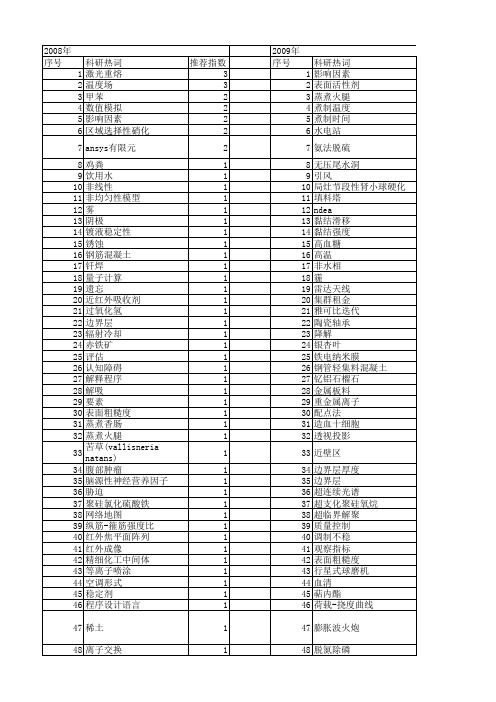
科研热词 推荐指数 激光重熔 3 温度场 3 甲苯 2 数值模拟 2 影响因素 2 区域选择性硝化 2 ansys有限元 2 鸡粪 1 饮用水 1 非线性 1 非均匀性模型 1 雾 1 阴极 1 镀液稳定性 1 锈蚀 1 钢筋混凝土 1 钎焊 1 量子计算 1 遗忘 1 近红外吸收剂 1 过氧化氢 1 边界层 1 辐射冷却 1 赤铁矿 1 评估 1 认知障碍 1 解释程序 1 解吸 1 要素 1 表面粗糙度 1 蒸煮香肠 1 蒸煮火腿 1 苦草(vallisneria natans) 1 腹部肿瘤 1 脑源性神经营养因子 1 胁迫 1 聚硅氯化硫酸铁 1 网络地图 1 纵筋-箍筋强度比 1 红外焦平面阵列 1 红外成像 1 精细化工中间体 1 等离子喷涂 1 空调形式 1 稳定剂 1 程序设计语言 1 稀土 1 离子交换 1 磷钼酸 1 磷钨酸 1 磨损 1 碱性燃料电池 1
1 1 1 1 1 1 1 1 1 1 1 1 1 1 1 1 1 1 1 1 1 1 1 1 1 1 1 1 1 1 1 1 1 1
107 108 109 110 111 112 113 114 115 116 117 118 119 120 121 122 123 124 125 126 127 128 129 130 131 132 133 134 135 136 137 138 139 140 141 142 143 144 145 146 147 148 149 150 151 152 153 154 155 156 157 158 159 160
耦合 综述 结构行为一致多尺度有限元模拟 结构健康监测 细菌总数的变化 线粒体呼吸代谢相关酶 纳米金刚石涂层 纤维素酶 纤维素 系统性红斑狼疮 糖尿病,2型 粗差 粉煤灰 粉土 稳定性 秸秆预处理 硅氢加成 瞬时转矩控制 相干结构 相关对称权函数 白细胞介素6 白细胞介素13受体 瘀热证 疗效 疏水性离子对 畜禽排泄物 电信号 甲醇 生物降解 生命周期 玉米秆 猪粪 焚烧 热湿交换 热导率 热丝法 激发 滤波器 溶质枝晶生长 溶胶-凝胶燃烧法 湍流边界层 温度场 渐进成形 浮游细菌 浓度场 流场 流动减阻 活性氧 泼尼松 污泥吸附 水解 氮磷去除能力 氧化应激 气象条件
2023年高考英语外刊时文精读专题14气候变化与珊瑚礁(含答案)

2023年高考英语外刊时文精读精练(14)Climate change and coral reefs气候变化与珊瑚礁主题语境:人与自然主题语境内容:自然生态【外刊原文】(斜体单词为超纲词汇,认识即可;下划线单词为课标词汇,需熟记。
)Human beings have been altering habitats—sometimes deliberately andsometimes accidentall y—at least since the end of the last Ice Age. Now, though, that change is happening on a grand scale. Global warming is a growing factor. Fortunately, the human wisdom that is destroying nature can also be brought to bear on trying to save it.Some interventions to save ecosystems are hard to imagine andsucceed. Consider a project to reintroducesomething similar to a mammoth(猛犸象)to Siberiaby gene-editing Asian elephants. Their feeding habits could restore the grassland habitat that was around before mammoths died out, increasing the sunlight reflected into space and helping keep carbon compounds(碳化合物)trapped in the soil. But other projects have a bigger chance of making an impact quickly. As we report, one example involves coral reefs.These are the rainforests of the ocean. They exist on vast scales: half a trillion corals line the Pacific from Indonesia to French Polynesia, roughly the same as the number of trees that fill the Amazon. They are equally important harbor of biodiversity. Rainforests cover18% of the land’s surface and offer a home to more than half its vertebrate(脊椎动物的)species. Reefs occupy0.1% of the oceans and host a quarter of marine(海洋的)species.And corals are useful to people, too. Without the protection which reefs afford from crashing waves, low-lying islands such as the Maldives would have flooded long ago, and a billion people would lose food or income. One team of economists has estimated that coral’s global ecosystem services are worth up to $10trn a year. reefs are, however, under threat from rising sea temperatures. Heat causesthe algae(海藻) with which corals co-exist, and on which they depend for food and colour, to generate toxins(毒素)that lead to those algae’s expulsion(排出). This is known as “bleaching(白化)”, and can cause a coral’s death. As temperatures continue to rise, research groups around the world are coming up with plansof action. Their ideas include identifying naturally heat-resistant(耐热的)corals and moving themaround the world; crossbreeding(杂交)such corals to create strains that are yet-more heat-resistant; employing genetic editing to add heat resistance artificially; transplantingheat-resistant symbiotic(共生的)algae; and even repairing with the bacteria and other micro-organismswith which corals co-exist—to see if that will help.The assisted evolution of corals does not meet with universal enthusiasm. Without carbon reduction and decline in coral-killing pollution, even resistant corals will not survive the century. Some doubt whetherhumans will get its act together in time to make much difference. Few of these techniques are ready for action in the wild. Some, such as gene editing, are so controversial that it is doubtful they will be approved any time soon. scale is also an issue.But there are grounds for optimism. Carbon targets are being set and ocean pollution is being dealt with. Countries that share responsibilities for reefs are starting to act together. Scientific methods can also be found. Natural currents can be used to facilitate mass breeding. Sites of the greatest ecological and economical importance can be identified to maximise benefits.This mix of natural activity and human intervention could serve as a blueprint (蓝图)for other ecosystems. Those who think that all habitats should be kept original may not approve. But when entire ecosystems are facing destruction, the cost of doing nothing is too great to bear. For coral reefs, at least, if any are to survive at all, it will be those that humans have re-engineered to handle the future.【课标词汇精讲】1.alter (通常指轻微地)改动,修改;改变,(使)变化We've had to alter some of our plans.我们不得不对一些计划作出改动。
加强炼镁传热效率的研究进展
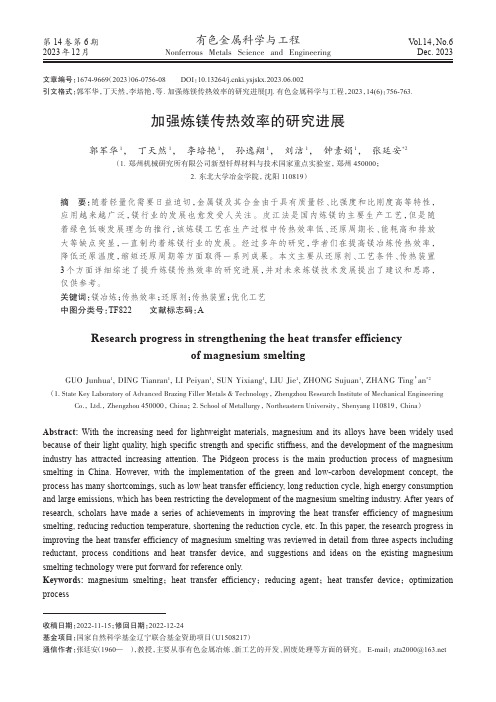
第14卷第6期2023年12月有色金属科学与工程Nonferrous Metals Science and EngineeringVol.14,No.6Dec. 2023加强炼镁传热效率的研究进展郭军华1, 丁天然1, 李培艳1, 孙逸翔1, 刘洁1, 钟素娟1, 张廷安*2(1.郑州机械研究所有限公司新型钎焊材料与技术国家重点实验室, 郑州 450000;2.东北大学冶金学院, 沈阳 110819)摘要:随着轻量化需要日益迫切,金属镁及其合金由于具有质量轻、比强度和比刚度高等特性,应用越来越广泛,镁行业的发展也愈发受人关注。
皮江法是国内炼镁的主要生产工艺,但是随着绿色低碳发展理念的推行,该炼镁工艺在生产过程中传热效率低、还原周期长、能耗高和排放大等缺点突显,一直制约着炼镁行业的发展。
经过多年的研究,学者们在提高镁冶炼传热效率,降低还原温度,缩短还原周期等方面取得一系列成果。
本文主要从还原剂、工艺条件、传热装置3个方面详细综述了提升炼镁传热效率的研究进展,并对未来炼镁技术发展提出了建议和思路,仅供参考。
关键词:镁冶炼;传热效率;还原剂;传热装置;优化工艺中图分类号:TF822 文献标志码:AResearch progress in strengthening the heat transfer efficiencyof magnesium smeltingGUO Junhua 1, DING Tianran 1, LI Peiyan 1, SUN Yixiang 1, LIU Jie 1, ZHONG Sujuan 1, ZHANG Ting ’an *2(1. State Key Laboratory of Advanced Brazing Filler Metals & Technology , Zhengzhou Research Institute of Mechanical EngineeringCo., Ltd., Zhengzhou 450000, China ; 2. School of Metallurgy , Northeastern University , Shenyang 110819, China )Abstract: With the increasing need for lightweight materials, magnesium and its alloys have been widely used because of their light quality, high specific strength and specific stiffness, and the development of the magnesium industry has attracted increasing attention. The Pidgeon process is the main production process of magnesium smelting in China. However, with the implementation of the green and low-carbon development concept, the process has many shortcomings, such as low heat transfer efficiency, long reduction cycle, high energy consumption and large emissions, which has been restricting the development of the magnesium smelting industry. After years of research, scholars have made a series of achievements in improving the heat transfer efficiency of magnesium smelting, reducing reduction temperature, shortening the reduction cycle, etc. In this paper, the research progress in improving the heat transfer efficiency of magnesium smelting was reviewed in detail from three aspects including reductant, process conditions and heat transfer device, and suggestions and ideas on the existing magnesium smelting technology were put forward for reference only.Keywords: magnesium smelting ; heat transfer efficiency ; reducing agent ; heat transfer device ; optimization process收稿日期:2022-11-15;修回日期:2022-12-24基金项目:国家自然科学基金辽宁联合基金资助项目(U1508217)通信作者:张廷安(1960— ),教授,主要从事有色金属冶炼、新工艺的开发、固废处理等方面的研究。
《2024年金属掺杂二维材料电催化CO2RR,HER,OER性能与机理的理论研究》范文

《金属掺杂二维材料电催化CO2RR,HER,OER性能与机理的理论研究》篇一一、引言随着人类对可再生能源和环境保护的需求日益增长,电催化技术因其能够将可再生能源转化为清洁能源并用于还原二氧化碳(CO2RR)、析氢反应(HER)和析氧反应(OER)等过程而备受关注。
金属掺杂的二维材料作为一种新兴的电催化剂,其独特的结构和性能使其在电催化领域具有巨大的应用潜力。
本文将重点研究金属掺杂二维材料在电催化CO2RR、HER、OER过程中的性能与机理,为推动电催化技术的发展提供理论支持。
二、金属掺杂二维材料的结构与性质金属掺杂的二维材料通常具有较大的比表面积、良好的导电性和优异的化学稳定性。
金属原子的掺入可以改变材料的电子结构和表面性质,从而影响其电催化性能。
本部分将详细介绍不同金属掺杂的二维材料的结构、性质及其在电催化领域的应用前景。
三、金属掺杂二维材料在CO2RR中的性能与机理CO2RR是一种将二氧化碳转化为有价值的化学产品的重要过程。
金属掺杂的二维材料作为电催化剂在CO2RR中表现出优异的性能。
本部分将通过理论计算和模拟,研究金属掺杂二维材料在CO2RR中的反应机理、活性位点以及影响因素,为设计高效的CO2RR电催化剂提供指导。
四、金属掺杂二维材料在HER中的性能与机理HER是水电解制氢的重要过程。
金属掺杂的二维材料因其良好的导电性和催化活性在HER中表现出显著的性能。
本部分将通过实验和理论计算,研究金属掺杂二维材料在HER中的反应路径、活性位点以及催化剂表面的电子结构变化,揭示其催化机理。
五、金属掺杂二维材料在OER中的性能与机理OER是水分解制氧的重要过程,但该过程需要较高的能量输入。
金属掺杂的二维材料在OER中表现出优异的性能,能够降低反应的过电位和能量消耗。
本部分将研究金属掺杂二维材料在OER中的反应动力学、催化剂表面的氧吸附和脱附过程以及催化剂的稳定性,为设计高效的OER电催化剂提供理论支持。
美铝专家出席中美工程前沿研讨会并介绍可持续性水处理技术

“ 美铝充 分认 识到 这一全 球 趋势 , 方案 。 了包括压 延产品 、 美铝 公司在 中国的承诺是坚定 除 硬铝挤 已经采取积极有效 的措施应 对 , 如 压产 品和铸件在内的铝产品和零部 和 明确 的。 中国的运 营中 , 在 美铝 采纳 自然生态系统来减少用水和进 件外 , 遵 美铝还营销美铝轮 毂、紧固 遵循 自己的价值观和 原则 , 守当 积极履行企业社会责 行水处理 。 我们欣喜地看 到,美铝 件 系统 、精密铸 件 以及建筑 系统 。 地法律法规 , 所研发 的自然生态系统可为各行各 美铝被瑞士达沃斯世界经济论坛评 任,倡导可持续发展 。 美铝 的 目标 业 及 社 区 的用 水 问题 提 供 务 实 、 有 选 为最 具 可持续 发展 性 的公 司之 是确保美铝公司和全体利益相关者 效和 可持续性 的解决方案 。 ”
一
,
连 续八年 入选道琼斯可持续发 的长 期成功 ,成 为本 地最 好 的公
在 过 去 的 六 年 中 , 铝 专 注 于 展指 数 。美铝在 3 个 国家拥有约 司 。 美 1 研 发 、 估 和 部署 具 有 革 新 性 、 评 低 6 , 0 0名 员工 。 3 0
成本和可持续性 的水管理技术和方 法, 从而取代传统 的造价 昂贵 的末
。 技术海报宣讲环节 , 为在座发 言嘉 为 ”增 强 型 自然 媒 介 过 滤 ”
工 。
美 铝在北京 、上 海 、秦 皇 岛、 昆山、苏州 、 广州和香 港等地建立 了办事处和生产厂 , 品主要包括 产
宾讲解 了美铝水处理技术 的战咯
“ 铝 的 自然 生 态 水 处 理 技 术 系 统 美
铝板带 、 固件 、 紧 汽车 部件 和建筑 有 效 地 减 少 了用 水 量 , 运 营 所 在 关 于 美锅 公 司 为 的 社 区 回馈 了更 多净 水 。 ” 美铝中国是 中国可持续发展 美 铝 公 司 是 世 界 领 先 的 氧 化 产品。
粉煤灰提取氧化铝的资源化利用
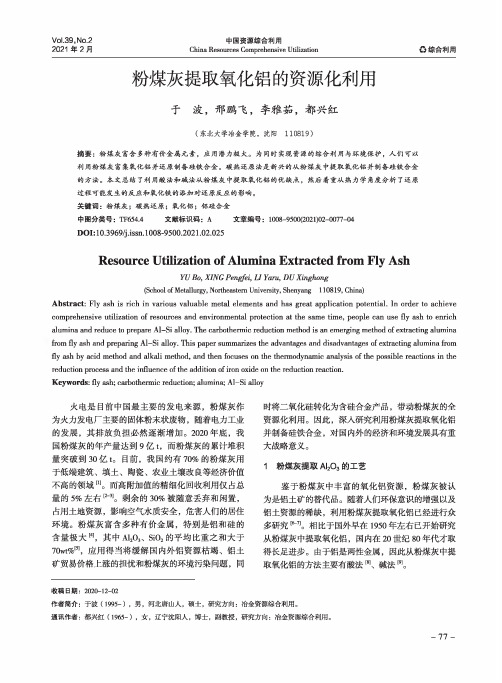
Vol.39,No.22021年2月中国资源综合利用China Resources Comprehensive Utilization 0综合利用粉煤灰提取氧化铝的资源化利用于 波,邢鹏飞,李雅茹,都兴红(东北大学冶金学院,沈阳110819)摘要:粉煤灰富含多种有价金属元素,应用潜力极大。
为同时实现资源的综合利用与环境保护,人们可以 利用粉煤灰富集氧化铝并还原制备硅铁合金。
碳热还原法是新兴的从粉煤灰中提取氧化铝并制备硅铁合金的方法。
本文总结了利用酸法和碱法从粉煤灰中提取氧化铝的优缺点,然后着重从热力学角度分析了还原 过程可能发生的反应和氧化铁的添加对还原反应的澎响。
关键词:粉煤灰;碳热还原;氧化铝;铝硅合金中图分类号:TF654.4文献标识码:A 文章编号:1008-9500(2021)02-0077-04DOI: 10.3969力.issn. 1008-9500.2021.02.025Resource Utilization of Alumina Extracted from Fly AshYU Bo, XING Pengfei, LI Yarn, DU Xinghong(School of Metallurgy, Northeastern University, Shenyang 110819, China)Abstract: Fly ash is rich in various valuable metal elements and has great application potential. In order to achievecomprehensive utilization of resources and environmental protection at the same time, people can use fly ash to enrich alumina and reduce to prepare Al-Si alloy. The carbothermic reduction method is an emerging method of extracting aluminafrom fly ash and preparing Al-Si alloy. This paper summarizes the advantages and disadvantages of extracting alumina fromfly ash by acid method and alkali method, and then focuses on the thermodynamic analysis of the possible reactions in the reduction process and the influence of the addition of iron oxide on the reduction reaction.Keywords: fly ash; carbothermic reduction; alumina; Al-Si alloy时将二氧化硅转化为含硅合金产品,带动粉煤灰的全资源化利用。
美国西北大大小写发现新型碳基复合材料
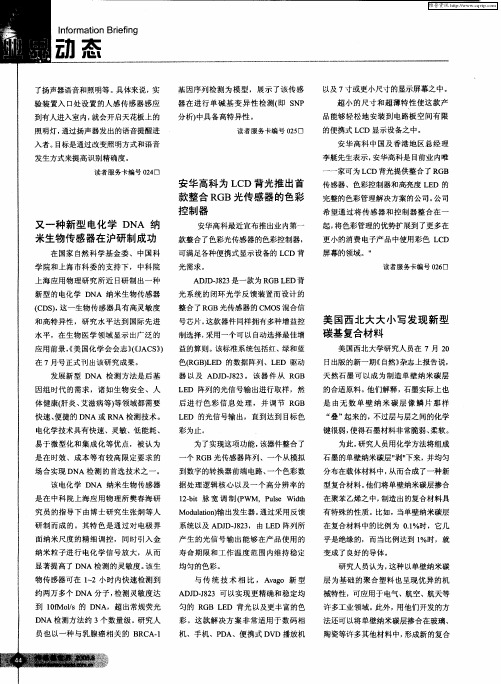
面纳米尺度 的精 细调控 ,同 时引入金
纳米粒子进 行 电化 学信 号放大 ,从而
产 生 的光信号输 出 能够 在产 品使用 的 寿 命期 限和工作温 度 范 围内维持稳 定
完整的色彩管理解决方案的公司 。 司 公 希望通 过将 传感器 和控制 器整合 在一 起, 将色彩管理 的优势扩展 到了更 多在
ห้องสมุดไป่ตู้
更小 的消 费电子产 品中使用 彩色 L D C 屏幕的领域 。”
读者服务卡编号 0 6 2口
可满足各种便携 式显示设备的 L D背 C
光需求 。 AD D. 2 J J 3是一款 为 R BL D背 8 G E 光系 统 的闭环 光学 反馈装 置而设 计的 整合 了R GB光传感器 的 C S混合信 MO
( DS , C ) 这一生物传感 器具有高灵敏度
和 高特异性 ,研 究水 平达 到国际先进 水 平,在生物 医学领 域显示 出广泛 的 应用前 景, 美 国化学会会 志》《AC 》 《 (J S )
号芯片 。 这款器件 同样拥有 多种增益控
制选择 , 采用一个可 以 自动选择最佳增
美 国西 北大 大小 写发现 新 型 碳 基复合材料
安华 高科 中国及 香港地 区总经 理 李艇先生表 示, 安华高科是 目前业 内唯
一 一
发生方式来提 高识别精确度 。
读者服 务卡编号 0 4 2口
家可为 L D背光提供整合 了R C GB
安华高科 为 L D背光推 出首 C 款整合 R B光传感器的色彩 G 控制器
布朗大学开发出可选择性地将CO2转化为CO的纳米金催化剂

d u s t r i a l a p p l i c a t i o n s .
Ke y Wo r ds :i on i c l i q ui d;s yn t he s i s ;m u l t i — s t a ge c ou nt e r c u r r e nt e x t r a c t i o n;t he s t r i n g c l a s s e x pe r i me n t : d e s ul f u r i z a t i o n
℃ P
~
V( I L ): V( H2 O2 ): V( g a s o l i n e ) 一1: 1: 1 O ,6 O。 C a n d r e v o l u t i o n s p e e d o f 6 0 0 r / ai r n .Af t e r t h e 4 s t a — g e s c o u n t e r c u r r e n t e x t r a c t i o n , t h e s u l f u r c o n t e n t o f t h e f e e d g a s o l i n e d e c r e a s e s t o 1 0 g g / g wi t h t h e s u l —
t i o n u s i n g h y d r o g e n p e r o x i d e( 3 0 % )a s t h e o x i d a n t . Th e d e s u l f u r i z a t i o n c o n d i t i o n s we r e c h e c k e d a n d
一
o p t i mi z e d b y c h a n g i n g t h e r a t i o o f I L s / o i l , e x t r a c t i o n t i me , t e mp e r a t u r e , a n d r a t e .T h e o r e t i c a l s t a g e s o f
国外锂金属电池研究成果

国外锂金属电池研究成果
国外在锂金属电池方面取得了一些重要的研究成果。
以下是近期的一些进展:
1. 美国马里兰大学的王春生教授和Hongli Wan等科研人员,成功研发出
Li7N2I-碳纳米管(LNI-CNT)和LNI-Mg两种新型多孔疏锂中间膜,有效解决了全固态锂金属电池(ASSLBs)的锂枝晶生长难题。
这一成果对电动
汽车行业乃至全球能源存储技术的发展产生了深远影响。
2. 美国哈佛大学工程与应用科学学院(Harvard John A. Paulson School Of Engineering And Applied Sciences,简称SEAS)的研究人员开发了
一种新型锂金属电池,可以充放电循环至少6000次,比任何其他袋式电池都要多,而且可以在几分钟内完成充电。
这项研究不仅描述了一种用锂金属阳极制造固态电池的新方法,而且为这些潜在的下一代电池提供了新的可能性。
如需更多关于国外锂金属电池研究成果的信息,建议查阅最新的科技新闻或者学术论文,或者关注各大科技公司和研究机构的官方发布。
纳米催化二氧化碳制甲醇英文

纳米催化二氧化碳制甲醇英文Nanocatalysis for the Production of Methanol from Carbon Dioxide.Carbon dioxide (CO2) is a significant greenhouse gas that contributes to global warming. However, converting it into useful chemicals such as methanol offers a sustainable and environmentally friendly approach to mitigate its adverse effects. Nanocatalysis, a field that utilizes nanoscale materials to catalyze chemical reactions, has emerged as a promising technology for this purpose.Nanocatalysis Principles and Applications.Nanocatalysis leverages the unique properties of nanomaterials, including their large surface area and high reactivity, to enhance catalytic activity. These nanomaterials, often in the form of nanoparticles or nanostructures, can significantly improve the rate and selectivity of chemical reactions. In the context of CO2conversion, nanocatalysts can lower the activation energy required for the reaction, making it more energetically favorable.CO2 to Methanol Conversion.The conversion of CO2 into methanol involves a multi-step process known as the methanol synthesis. Typically, this process requires high temperatures and pressures, as well as a suitable catalyst. Nanocatalysts cansignificantly reduce these requirements, making the process more energy-efficient and cost-effective.The most common nanocatalysts used for CO2 hydrogenation to methanol are based on copper. Copper nanoparticles, due to their high activity and selectivity, are particularly effective in promoting this reaction. Other metals, such as palladium and platinum, have also been explored for this purpose.Nanocatalyst Design and Optimization.The design and optimization of nanocatalysts for CO2 conversion are crucial for achieving high catalytic performance. Factors such as particle size, shape, and composition can significantly influence the catalytic activity. For instance, smaller nanoparticles typically exhibit higher catalytic activity due to their increased surface area. Similarly, the choice of support material can also affect the stability and activity of the nanocatalyst.Challenges and Future Prospects.While nanocatalysis offers significant potential for CO2 conversion, several challenges need to be addressed. One of the main challenges is the scalability of nanocatalysts for industrial applications. Current methods for synthesizing nanomaterials are often not suitable for large-scale production. Additionally, the stability of nanocatalysts under reaction conditions is also a concern, as they can often deactivate or agglomerate over time.Future research efforts should focus on developing more stable and scalable nanocatalysts for CO2 conversion.Innovations in nanomaterials synthesis and characterization techniques can help address these challenges. Furthermore, integrating nanocatalysts with other renewable energy sources, such as solar or wind power, can further enhance the sustainability of the process.In conclusion, nanocatalysis holds promise for the efficient conversion of CO2 into methanol. By leveraging the unique properties of nanomaterials, we can develop more effective and sustainable catalysts for this important reaction. Future research in this area could lead to significant advancements in green chemistry and help mitigate the impact of climate change.。
石墨烯制备及其在新能源汽车锂离子电池负极材料中的应用
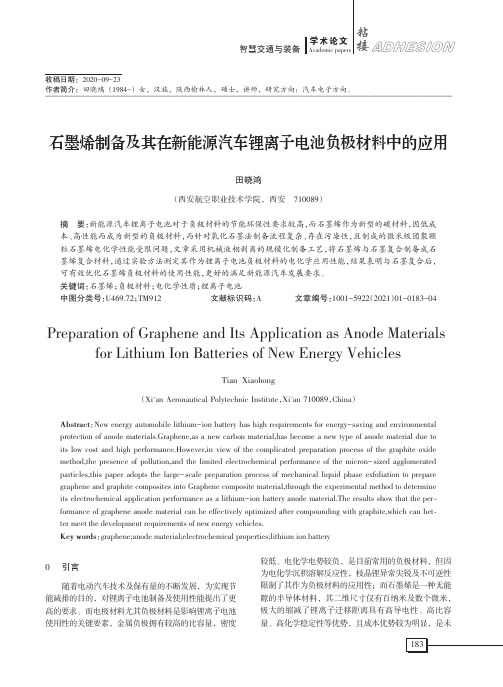
石墨烯制备及其在新能源汽车锂离子电池负极材料中的应用田晓鸿(西安航空职业技术学院,西安710089)摘要:新能源汽车锂离子电池对于负极材料的节能环保性要求较高,而石墨烯作为新型的碳材料,因低成本、高性能而成为新型的负极材料,而针对氧化石墨法制备流程复杂、存在污染性,且制成的微米级团聚颗粒石墨烯电化学性能受限问题,文章采用机械液相剥离的规模化制备工艺,将石墨烯与石墨复合制备成石墨烯复合材料,通过实验方法测定其作为锂离子电池负极材料的电化学应用性能,结果表明与石墨复合后,可有效优化石墨烯负极材料的使用性能,更好的满足新能源汽车发展要求。
关键词:石墨烯;负极材料;电化学性质;锂离子电池中图分类号:U469.72;TM912文献标识码:A文章编号:1001-5922(2021)01-0183-04 Preparation of Graphene and Its Application as Anode Materials for Lithium Ion Batteries of New Energy VehiclesTian Xiaohong(Xi'an Aeronautical Polytechnic Institute,Xi'an710089,China)Abstract:New energy automobile lithium-ion battery has high requirements for energy-saving and environmental protection of anode materials.Graphene,as a new carbon material,has become a new type of anode material due to its low cost and high performance.However,in view of the complicated preparation process of the graphite oxide method,the presence of pollution,and the limited electrochemical performance of the micron-sized agglomerated particles,this paper adopts the large-scale preparation process of mechanical liquid phase exfoliation to prepare graphene and graphite composites into Graphene composite material,through the experimental method to determine its electrochemical application performance as a lithium-ion battery anode material.The results show that the per⁃formance of graphene anode material can be effectively optimized after compounding with graphite,which can bet⁃ter meet the development requirements of new energy vehicles.Key words:graphene;anode material;electrochemical properties;lithium ion battery0引言随着电动汽车技术及保有量的不断发展,为实现节能减排的目的,对锂离子电池制备及使用性能提出了更高的要求。
温和条件下混合金属离子氧化木质素耦合电化学产氢

林业工程学报,2023,8(5):130-137JournalofForestryEngineeringDOI:10.13360/j.issn.2096-1359.202304014收稿日期:2023-04-19㊀㊀㊀㊀修回日期:2023-07-25基金项目:国家自然科学基金(22278446);湖南省自然科学基金(2022JJ10071)㊂作者简介:徐伟卓,男,博士生,研究方向为生物质能源转化与绿色产氢㊂通信作者:刘伟,男,教授㊂E⁃mail:wliu300@csu.edu.cn温和条件下混合金属离子氧化木质素耦合电化学产氢徐伟卓1,2,周冰洁3,李宁1,刘伟4∗(1.中国科学院大连化学物理研究所,大连116023;2.中国科学院大学,北京100049;3.中国汽车技术研究中心有限公司,天津300300;4.中南大学化学化工学院,长沙410083)摘㊀要:随着化石能源的枯竭以及温室效应的加剧,可再生资源的开发和利用已经成为全球关注的焦点㊂生物质是地球上最丰富的可再生资源,其可转化为化学品和燃料,具有广阔的应用前景㊂笔者提出一种简单㊁环境友好的电化学方法,在温和的反应条件下,利用廉价的混合过渡金属离子Fe3+⁃Cu2+作为电子转移载体和均相催化剂,将木质素的氧化与电化学产氢相结合,在降解木质素为芳香化合物的同时得到清洁㊁高能量密度的氢气㊂通过线性循环伏安曲线(CV)㊁极化曲线(I⁃V)㊁电压⁃时间曲线(V⁃t)㊁气质联用(GC⁃MS)㊁液相色谱(LC)以及分光光度法等测试方法研究了木质素氧化程度㊁产物㊁木粉含量变化以及电化学性能等情况㊂通过混合Fe3+与不同的过渡金属离子Cu2+㊁Cr3+㊁Ni2+及Co2+协同氧化木质素,发现Fe3+⁃Cu2+的效果最为显著,木质素的降解率约48%,在100mA/cm2的电流密度下可以通电2.5h㊂通过连续的化学⁃电解实验,未化学预处理原生木粉的降解率提高至62.8%,同时获得香兰素㊁葡萄糖和甲酸等有机小分子产物和氢气㊂关键词:混合金属离子;氧化木质素;电化学;产氢中图分类号:TQ35㊀㊀㊀㊀㊀文献标志码:A㊀㊀㊀㊀㊀文章编号:2096-1359(2023)05-0130-08ElectrochemicalhydrogenproductioncoupledwithligninoxidationbymixedmetalionsundermildconditionsXUWeizhuo1,2,ZHOUBingjie3,LINing1,LIUWei4∗(1.DalianInstituteofChemicalPhysics,ChineseAcademyofSciences,Dalian116023,China;2.UniversityofChineseAcademyofSciences,Beijing100049,China;3.ChinaAutomotiveTechnology&ResearchCenterCo.Ltd.,Tianjin300300,China;4.SchoolofChemistryandChemicalEngineering,CentralSouthUniversity,Changsha410083,China)Abstract:Withthedepletionoffossilenergyandtheintensificationofthegreenhouseeffect,itisurgenttodevelopandutilizerenewableresourcestoeffectivelyreducethedependenceonfossilenergy.Itiswellknownthatbiomassisthemostabundantrenewableresourceonearth,withgreatpotentialforconversionintochemicalsandfuelsfromawiderangeofsources.Aseriesoftechniqueshasbeendevelopedfortheconversionofbiomass.However,nativebiomasscontainscomplexchemicalcompositions,especially,ligninisthemaincomponentofcellwallsofbiomasswithrigidstructure,whichisextremelydifficulttoconvertanddegrade.Theconversionofligningenerallyrequireshightempera⁃tureandhighpressure.However,theharshconditionswouldeasilycausethedeactivationofcatalystandsidereactions.Electrocatalysisisacleanandefficienttechnology,whichcouldcontrolthechemicalreactionsbycontrollingtheelectri⁃calinput.Inthisstudy,asimpleandenvironmentallyfriendlyelectrochemicalmethodisproposed.Undermildreactionconditions,cheaptransitionmetalionsFe3+⁃Cu2+wereusedastheelectrontransfercarriersandhomogeneouscatalystsforligninoxidation,andtheregenerationoflowvalentmetalionswascoupledwithelectrochemicalhydrogenproduc⁃tion.Throughthechemical⁃electrolysisprocess,cleanandhighenergydensityhydrogenwasobtainedwhileligninwasdegradedintoaromaticcompounds.Thelinearcyclicvoltammetry(CV),polarizationcurves(I⁃V),voltage⁃timecurves(V⁃t),gas⁃massspectrometry(GC⁃MS),liquidchromatography(LC)andspectrophotometricmethodwereusedtoinvestigatethedegreeofligninoxidation,products,variationofcontentandelectrochemicalperformance.BymixingFe3+withdifferenttransitionmetalionsCu2+,Cr3+,Ni2+andCo2+forthesynergisticoxidationoflignin,itwasfoundthatFe3+⁃Cu2+hadthemostsignificanteffect.Duringtheheatingprocess,about48%oftheligninsolidsweresolubilizedandconvertedintoaromaticcompounds,suchasvanillinanddimethylphthalate.Thesolutioncouldbeelec⁃trifiedfor2.5hataconstantcurrentdensityof100mA/cm2accompaniedbythecontinuousproductionofhydrogen.Throughcontinuouschemical⁃electrolysisexperiments,upto62.8%oftheunpretreatednativewoodflourwasdepoly⁃㊀第5期徐伟卓,等:温和条件下混合金属离子氧化木质素耦合电化学产氢merizedandsolubilizedintothesolution,whileorganicsmallmoleculeproductssuchasvanillin,glucoseandformicacidwereobtained,simultaneously,cleanhydrogenwasgeneratedatthecathodeatalowelectrolysisenergyconsump⁃tion.Thisstudyprovidesasimpleandefficientmethodforthedegradationofligninandgenerationofhydrogenundermildconditions,whichisexpectedtobeappliedtotheefficienthydrogenproductionfromabundantnativebiomass.Keywords:mixedmetalion;ligninoxidation;electrochemistry;hydrogenproduction㊀㊀随着全球能源的短缺以及对化学品㊁燃料需求的不断增长,越来越多的研究人员致力于开发和利用可持续化学资源,以此降低对化石能源的依赖㊂生物质能是一种完全可再生的清洁能源,来源于生物质㊂据估计,生物质资源每年可达181.5亿t,是全球最大的可再生资源[1]㊂生物质中的碳来自大气中的二氧化碳,通过光合作用转化为各种有机物,在其利用过程中又生成二氧化碳和水,形成循环,可以减缓温室气体排放和全球变暖的趋势[2]㊂木质纤维素生物质主要由纤维素㊁半纤维素和木质素组成㊂其中,纤维素是含量最丰富的组分,是由葡萄糖单元通过β⁃1,4⁃糖苷键重复连接而形成的线性聚合物;半纤维素是由吡喃糖和呋喃糖组成的无定型聚合物[3],二者已经被开发并转化为糖基平台化合物,如左旋葡萄糖酮[4]㊁5⁃羟甲基糠醛[5]㊁乙醇[6]等;木质素是单体间以碳⁃氧键和碳⁃碳键随机连接的复杂高分子,极难降解并且容易发生缩合反应[7],因此木质素的有效利用是重大挑战㊂通常,木质素作为造纸工业中的 废物 ,其利用率仅为2% 5%,其余部分用于燃烧发电或者直接作为废水进行处理[8]㊂在过去几十年中,已经开发了一系列转化策略,将木质素降解为燃料或小分子化学品,包括氢解㊁热解㊁酶解和氧化[9]㊂Kumar等[10]利用铜催化剂在280ħ的高温下将木质素转化为高质量的生物油㊂Kumar等[11]发现Cu/γ⁃Al2O3在高压氧气的作用下可以将木质素转化为生物油,其收率可达74.3%㊂Zirbes等[12]以镍作为阳极电极,在160ħ下,硫酸盐木质素被降解为香兰素,但其电流密度较小,仅为10mA/cm2㊂Rauber等[13]利用复合电催化剂Ru0.2Mn0.2Ir0.6Ox,在三乙基甲磺酸铵离子液体中氧化木质素得到香兰素和香草酸,收率约11.5%㊂近年来,一些均相催化剂也被应用于木质素的氧化升级过程中㊂Zirbes等[14]利用过氧二碳酸盐作为绿色氧化剂,在180ħ下将硫酸盐木质素氧化解聚制备香兰素,收率可达到92%㊂多金属氧酸盐具有强酸性㊁强氧化性㊁高质子迁移率㊁快速可逆的多电子转移以及氧化降解性,是均相电催化反应的研究热点,也被应用于木质素的转化升级过程中[15]㊂然而多金属氧酸盐的高分子量和较低溶解度导致很难获得高摩尔浓度的催化剂,并且多金属氧酸盐团簇分子的扩散速率较慢,这些阻碍了木质素的氧化以及阳极表面放电反应㊂因此,选择低成本且具有氧化性的小分子来代替多金属氧酸盐,有望提高木质素氧化速率以及电解性能[16]㊂Liu等[17]将玉米秸秆用氯化铁预处理,可以去除几乎所有的半纤维素,断裂木质素和碳水化合物之间的醚键㊁酯键,破坏玉米秸秆表面㊂生物质是地球上丰富的可再生资源,而氢能是一种环境友好的清洁能源㊂将生物质利用与产氢相结合,可以实现持续的可再生产氢㊂笔者通过一种化学⁃电解转化过程,在温和条件下,利用简单混合过渡金属离子Fe3+⁃Cu2+协同促进木质素以及原生木粉氧化,同时耦合电化学产氢,其转化过程见图1㊂Fe3+㊁Cu2+可以与碳水化合物中的氧原子配位促进化学键的断裂,同时Fe3+氧化木质素中的酚单元得到香兰素等芳香族单体,Fe3+被还原为Fe2+;此外,弱氧化性的Cu2+也会发生部分还原㊂在电解过程中,还原态的Fe2+㊁Cu2+在低电能消耗下重新再生为Fe3+以及Cu2+,耦合阴极产生氢气,实现木质素的氧化降解及高效产氢㊂通过连续的化学⁃电解实验,混合Fe3+⁃Cu2+可以将未化学预处理的原生木粉氧化㊂图1㊀化学⁃电解转化过程的实验机理图Fig.1㊀Schematicillustrationofthechemical⁃electricconversionprocess1㊀材料与方法1.1㊀试验材料FeCl3㊃6H2O(纯度99.95%)㊁CuCl2㊃2H2O(分析纯)㊁CrCl3㊃6H2O(纯度98%)㊁NiCl2㊃6H2O(分析纯)㊁CoCl2㊃6H2O(分析纯)㊁脱碱木质素(DL)㊁酶131林业工程学报第8卷木质素(EL)㊁H3PO4(体积分数85%)㊁无水硫酸钠(纯度99%)㊁葡萄糖(纯度99%)㊁果糖(纯度99%)㊁甲酸(体积分数98%)㊁乙酰丙酸(纯度ȡ98%),均购自上海麦克林生化科技有限公司㊂HCl(分析纯)㊁二氯甲烷(DCM,体积分数99.5%)㊁萘(纯度ȡ99.7%),均购自国药集团化学试剂有限公司㊂NaOH(纯度96%),购自上海阿拉丁生化科技股份有限公司㊂磷钼酸水合物(H3PMo12O40㊃xH2O(PMo12),纯度ȡ72%),购自上海毕得医药科技股份有限公司㊂实验用水为自制超纯水㊂1.2㊀仪器设备2500Y型高速多功能粉碎机(永康市铂欧五金制品有限公司),MS7⁃H550⁃Pro数显加热型磁力搅拌器(大龙兴创实验仪器股份公司),Interface1010E型电化学工作站(美国Gamry),722N可见分光光度计(上海佑科仪器仪表有限公司),QP2010SE型气相色谱质谱联用仪(GC⁃MS,日本岛津),LC⁃16型液相色谱仪(LC,日本岛津),WGL⁃45B型电热鼓风干燥箱(天津市泰斯特仪器有限公司),AUW220D型电子天平(日本岛津),Q⁃LAB10⁃DI型超纯水机(湖南启沁环保科技有限公司),DIPump550⁃B253型蠕动泵(卡川尔流体科技(上海)有限公司)㊂1.3㊀试验方法1.3.1㊀原生木粉含水量测试用高速多功能粉碎机将原生木材以39000r/min的速度搅打2min,使其变成粉末状㊂称取适量的木粉粉末于培养皿中,称量初始质量后放入烘箱,在90ħ下烘至质量恒定㊂根据烘干前后的质量数据计算得到原生木粉的含水量为6.2%㊂1.3.2㊀混合金属离子氧化降解木质素以及原生木粉㊀㊀利用20mLFeCl3㊃6H2O(1mol/L)⁃HCl(1mol/L)和Mo6+(1.2mol/L,含0.1mol/LPMo12)分别作为氧化剂,氧化脱碱木质素㊁酶木质素以及原生木粉,底物的质量浓度为5g/L㊂将盛有反应溶液的反应瓶置于磁力搅拌加热器,加热至100ħ后向其中慢慢加入底物,在100ħ下加热回流3h㊂反应完毕后,利用玻璃砂芯真空过滤装置进行固液分离并保留滤液㊂此外,在相同的反应条件下,分别引入0.1mol/LCu2+㊁Cr3+㊁Ni2+㊁Co2+4种金属离子协同Fe3+氧化降解脱碱木质素,同时也利用弱氧化性的CuCl2㊃2H2O(1mol/L)⁃HCl(1mol/L)进行脱碱木质素的氧化降解实验㊂为了测试降解率,利用50mLFeCl3㊃6H2O(1mol/L)⁃HCl(1mol/L)氧化脱碱木质素以及原生木粉(10g/L),100ħ下加热回流3h㊂反应完毕固液分离后,利用超纯水清洗滤渣㊂将水洗后的滤渣放入烘箱,于100ħ下烘至质量恒定㊂根据烘干前后的质量计算脱碱木质素以及原生木粉的降解率㊂1.3.3㊀液流电池的组装以及电化学测试1)液流电池的组成部分包括2块端板㊁2块电极板以及质子交换膜㊂选取高密度石墨材料制成电极板,阴阳两极分别雕刻一个蛇形流道,几何面积为1cm2㊂在电极板上下两端留有液体流入和流出的孔洞㊂阳极流道中嵌入石墨毡,用以增加与阳极液的接触面积㊂阴极流道中,在石墨电极表面均匀修饰一层析氢性能较好的铂催化剂㊂质子交换膜置于两块电极板之间,完全阻隔阴阳槽,外圈使用硅胶垫片增加电极板之间的紧密性,将端板安装在两侧,用聚四氟乙烯(PTFE)垫圈以及螺丝钉固定,PTFE管用于连接液流电池和蠕动泵,可以连续地将电解液输送至液流电池㊂2)以木质素以及原生木粉的反应滤液为研究对象,进行电解产氢实验㊂反应溶液储存在阳极槽中,H3PO4溶液(1mol/L)储存在阴极槽中,然后分别泵送至电池的阳极和阴极㊂接通电源后在不同温度以及电压下测试溶液的极化曲线,之后在100mA/cm2的电流密度下进行电解实验㊂随着通电的进行,阳极溶液中还原态的金属离子被重新氧化,可以观察到阳极液逐渐由浅绿色变为黄色,阴极不断有氢气气泡产生㊂将产生的氢气通过排水法收集,计算法拉第效率㊂通电过程中利用电化学工作站记录随时间变化的电压㊁电流数值㊂为了探究金属离子作为均相催化剂进行木质素降解和产氢的作用,将不含金属离子的木质素(5g/L)以及木质素(5g/L)⁃盐酸(1mol/L)混合物在加热之后过滤,将滤液和H3PO4溶液(1mol/L)分别输送至电池的阳极和阴极,测试其在不同电压下的电流密度㊂利用Fe3+⁃Cu2+进行脱碱木质素以及原生木粉(10g/L)的连续化学⁃电解氧化降解实验,首先在100ħ下利用FeCl3㊃6H2O(1mol/L)⁃CuCl2㊃2H2O(0.1mol/L)⁃HCl(1mol/L)溶液氧化降解木质素及木粉,反应3h之后滤液通入电池阳极;在室温和100mA/cm2的电流密度下进行恒电流电解实验,当施加的电压急剧上升时,表明溶液中金属离子完全再生,此时立即停止电解;利用再生之后的金属离子溶液在100ħ下继续氧化未反应的底物㊂测试加热⁃电解循环实验后底物的降解率㊂3)使用Pt丝对电极和直径3mm的石墨电极231㊀第5期徐伟卓,等:温和条件下混合金属离子氧化木质素耦合电化学产氢在电化学工作站上测试线性循环伏安曲线,参比电极为Ag/AgCl电极㊂0.26mol/LPMo12与0.1mol/LFeCl3⁃0.1mol/LHCl为研究对象,扫描速率为50mV/s㊂使用Nernst方程[18]将电极电势转换为可逆氢电极(RHE)㊂4)木质素氧化反应滤液的电极电势通过将电流设置为1ˑ10-9A测试,其中石墨作为工作电极,饱和Ag/AgCl作为对电极和参比电极分别与电化学工作站相连㊂12FeCl3(0.1mol/L)⁃HCl(0.1mol/L)水溶液的线性循环伏安曲线;b)1mmol/LPMo12的线性循环伏安曲线,插图为1mmol/LPMo12以及1mmol/LFeCl3溶液的电流⁃扫速1/2拟合曲线;c e)分别为脱碱木质素溶液㊁酶木质素溶液和原生木粉溶液的电压⁃时间曲线㊂图2㊀线性循环伏安曲线及电压⁃时间曲线Fig.2㊀Cyclicvoltammetrycurvesandvariationofappliedpotentialvs.timeduringtheelectrolysis5)使用直径3mm的玻碳电极为工作电极,铂丝为对电极,Ag/AgCl为参比电极,测试FeCl3及PMo12溶液的循环伏安曲线㊂其中PMo12以及FeCl3的浓度为1mmol/L,扫描速率依次设置为2,4,6,8和10mV/s㊂根据Randles⁃Sevcik方程计算峰电流(ip)和斜率k[19]㊂1.3.4㊀脱碱木质素以及原生木粉氧化产物分析利用DCM萃取脱碱木质素以及原生木粉氧化滤液中的产物,萘为内标物,并用无水硫酸钠进行干燥㊂使用GC⁃MS分析产物,色谱柱为SH⁃I⁃5MS(30mˑ0.25mmˑ0.25μm,长ˑ直径ˑ填料粒径);质谱仪(EI,200ħ)载气为氦气,流速为1mL/min,不分流㊂进样温度为250ħ,保持20min㊂将GC烘箱编程为50ħ,持续2min;然后以10ħ/min的速度升温,直到温度达到200ħ,并在此温度下保持5min㊂另外,取少量原生木粉氧化之后的滤液,加入阳离子交换树脂置换其中的金属离子,之后利用配置示差检测器以及紫外检测器的岛津液相色谱仪进行分析,色谱柱为SugarSH1821(8.0mˑ300mmˑ6μm,长ˑ直径ˑ填料粒径),流动相为5mmol/LH2SO4溶液,流速为0.6mL/min㊂1.3.5㊀木质素浓度⁃吸光度标准曲线测试以及木粉残渣的成分分析㊀㊀配制质量分数2.5%的NaOH溶液,将脱碱木质素加入NaOH溶液中加热溶解㊂分别测试不同波长下木质素溶液的吸光度,发现在360nm处有较好响应,之后配制一系列质量分数的木质素溶液,在360nm波长处测定吸光度值,绘制木质素浓度⁃吸光度标准曲线㊂将适量原生木粉以及被氧化之后的木粉残渣烘至质量恒定,加入至2.5%的NaOH溶液中加热,在360nm下测试上清液的吸光度㊂通过木质素浓度⁃吸光度的标准曲线,计算出原生木粉以及木粉残渣中木质素的含量,进而计算出纤维素以及半纤维素的含量㊂2㊀结果与分析2.1㊀磷钼酸以及Fe3+分别氧化降解木质素和木粉为比较Mo6+以及Fe3+的氧化能力,分别测试了磷钼酸以及氯化铁的循环伏安曲线,结果如图2a所示㊂其中Mo6+的氧化电位为0.8113V,Fe3+的氧化电位为0.9897V,二者的氧化能力相近㊂331林业工程学报第8卷通过循环伏安曲线以及Randles⁃Sevcik方程,测试比较了PMo12以及FeCl3溶液中离子的扩散系数,结果如图2b所示㊂结果表明,Fe2+的扩散系数约为磷钼酸团簇的1.8倍,这表明Fe2+具有更快的扩散速率,有利于其在电极表面的氧化反应㊂此外,分别利用Mo6+以及Fe3+⁃HCl氧化脱碱木质素㊁酶木质素以及原生木粉㊂在加热过程中,木质素以及原生木粉被降解为小分子物质,同时Mo6+和Fe3+分别被还原为Mo5+和Fe2+㊂反应结束后滤液通入质子交换膜燃料电池,在恒电流电解下滤液中的在恒电流通电下的电压⁃时间曲线;d)产物的GC⁃MS图;e)CuCl2⁃HCl在100ħ氧化脱碱木质素3h后溶液的极化曲线;f)恒电流通电下电压⁃时间曲线㊂图3㊀过渡金属离子⁃木质素溶液的电化学测试结果及产物分析Fig.3㊀Electrochemicaltestresultsoftransitionmetalions⁃ligninsolutionsandproductanalysisMo5+和Fe2+重新氧化再生,电压⁃时间曲线如图2c e所示㊂在100mA/cm2的电流密度下磷钼酸溶液所需的电压很快增加至1.00V以上,随着Mo5+逐渐被氧化,电压增加至1.23V后开始发生析氧副反应,电压直线上升㊂然而,Fe3+/Fe2+⁃HCl溶液需要的电压为0.80 1.00V,通电时间更久,是磷钼酸溶液的2 5倍㊂这说明在加热过程中,尽管0.1mol/L的磷钼酸中含有1.2mol/LMo6+,磷钼酸结构中的Mo6+利用率却很低,无法完全参与生物质的氧化过程,导致还原态Mo5+的浓度很低,并且团簇磷钼酸在电极表面扩散较慢,限制了它在电极表面的反应㊂虽然1mol/L的Fe3+浓度较低,但是每个Fe3+都可以在加热过程中夺取木质素的电子,得到更高浓度的Fe2+,而且低分子质量的Fe2+可以很快扩散至电极表面,较低的电压就可以实现Fe2+的氧化再生㊂2.2㊀混合简单金属离子协同氧化降解脱碱木质素为了提高脱碱木质素的氧化程度,分别选择过渡金属离子Cu2+㊁Cr3+㊁Ni2+以及Co2+与Fe3+混合,协同氧化脱碱木质素,反应之后固液分离,脱碱木质素的降解率为47% 48%,滤液的电化学测试结果如图3所示㊂相比于单独的Fe3+溶液,在混合过渡金属离子作用下,滤液的电极电位变小(图3a),相同电压下极化电流更高(图3b),并且溶液在100mA/cm2的电流密度下可以维持更久的通电时间(图3c)㊂Cu2+㊁Cr3+㊁Ni2+及Co2+过渡金属离子具有空轨道,其可以与木质素中的供氧部分进行配位,有效削弱木质素结构中的醚键,Fe3+可以更容易地将木质素氧化,从而导致更高的Fe2+浓度和更长的电解产氢时间㊂在电解过程中,木质素氧化释放的质子迁移至阴极,H+在铂/石墨上被还原产生氢气,这可以实现低能耗下持续的化学电解制氢㊂利用GC⁃MS对木质素氧化产物进行分析,结果如图3d所示,主要产物是香兰素和邻苯二甲酸二甲酯,还有少量对羟基苯甲醛㊁香草乙酮等㊂在4种过渡金属离子组合中,Fe3+⁃Cu2+溶液的通电时间最长约2.5h(图3c)㊂为了探究Cu2+的作用,利用CuCl2⁃HCl氧化脱碱木质素,反应溶液的电极电位为0.6051V,极化曲线以及电压⁃时间曲线如图3e和f所示,在1.20V的极化电压下,溶液极化电流431㊀第5期徐伟卓,等:温和条件下混合金属离子氧化木质素耦合电化学产氢为266mA/cm2(25ħ),其在0.80V电压下可以维持约2000s的通电时间㊂尽管Cu2+的氧化电位较低(0.1590V),但是由于Cu2+可以通过配位作用削弱醚键,因此Cu2+也可以一定程度上氧化木质素中的酚单元㊂为探究FeCl3㊁CuCl2作为均相催化剂进行木质素降解和产氢的作用,对比了不含FeCl3㊁CuCl2催化剂时木质素溶液的极化曲线,结果如图4a所示㊂当不含FeCl3㊁CuCl2催化剂的木质素溶液或者木质素⁃盐酸溶液通入阳极时,由于大分子木质素很难在廉价的石墨电极表面发生氧化,所以得到的电流密度很小,当电压为1.20V时,电流密度也仅为39mA/cm2㊂当FeCl3以及CuCl2分别作为催化剂和氧化剂时,其在加热条件下可以氧化木质素得到还原态金属离子,而还原态的金属离子在电解时可以更容易地在石墨电极上氧化再生,当电压为1.20V时,电流密度可以达到249mA/cm2㊂此外,根据极化曲线测试的结果计算对比了有无催化剂时木质素溶液作为阳极液的电解产氢量㊂当工作电压为0.85V时,Fe3+⁃Cu2+⁃木质素溶液作为阳极液,其电流密度为100mA/cm2,在1h内可以得到45.7mLH2(常温常压);而没有催化剂的木质素溶液只能维持约10mA/cm2的电流密度,1h内产氢体积仅4.6mL(常温常压),远小于含有Fe3+⁃Cu2+催化剂时的产氢量㊂这些结果表明Fe3+⁃Cu2+作为催化剂可以实现木质素高效产氢㊂2.3㊀Fe3+氧化降解原生木粉利用原生木粉作为底物进行化学⁃电解实验,以此探究金属离子对原生生物质的降解作用㊂同样的,在100ħ下Fe3+可以氧化原生木粉为小分子产物,同时Fe3+还原为Fe2+㊂固液分离后,测试木粉降解率为47.4%,将滤液通入质子交换膜燃料电池测试极化曲线,结果如图4b所示㊂随着温度的升高,Fe2+扩散速度加快,有利于其在电极表面的氧化反应,因此在相同电压下,温度越高,极化电流越大㊂在100mA/cm2的恒电流电解过程中,滤液可以维持约2.4h的通电时间(图2e)㊂原生木粉中主要成分除了木质素还有纤维素和半纤维素,Fe3+可以与纤维素中的糖苷键进行配位,促进其水解和氧化㊂木粉降解产物的GC⁃MS以及LC结果如图4c和d所示,芳香产物主要是香兰素㊁邻苯二甲酸二甲酯以及少量对羟基苯甲醛㊁5⁃氯香草醛等㊂木粉中的纤维素和半纤维素在Fe3+的水解及氧化作用下降解为小分子的葡萄糖㊁果糖㊁甲酸和乙酸等㊂a)木质素⁃不同催化剂溶液的极化曲线;b)FeCl3⁃HCl在100ħ氧化原生木粉3h后溶液的极化曲线;c)产物的GC⁃MS图;d)产物的LC图㊂图4㊀木质素和木粉降解溶液的极化曲线及木粉降解产物分析Fig.4㊀Polarizationcurvesofligninandwoodsolutionsafteroxidationandproductanalysis2.4㊀Fe3+⁃Cu2+连续氧化降解脱碱木质素以及原生木粉㊀㊀通过连续加热⁃通电实验提高脱碱木质素以及原生木粉的降解率㊂在Fe3+的基础上加入适量Cu2+,以此促进木粉的水解以及氧化㊂在加热过程中Fe3+⁃Cu2+氧化木质素被还原为Fe2+⁃Cu+,通入电531林业工程学报第8卷池后在低电位下金属离子被氧化再生,得到的Fe3+⁃Cu2+继续氧化剩余木质素以及木粉㊂3次加热之后,木质素和木粉的降解率为64.3%和62.8%,相比单次加热实验,提高了约17%㊂溶液中HCl酸性很强,而木质素在酸性溶液中极易发生不可逆的缩合反应,其降解率较难提高,因此第二次加热后溶液的通电时间大大缩短,如图5a和b所示㊂此外,通过分光光度法探究了原生木粉以及木粉残渣的组成成分,在360nm下,测试了木质素质量浓度⁃吸光度的标准曲线(图5c)㊂将原生木粉以及木粉残渣分别用NaOH处理并测试上清液的吸光度,根据标准曲线得到了木粉以及残渣中木质素㊁纤维素以及半纤维素的含量,结果见图5d㊂氧化3次之后,木粉残渣中木质素质量分数增加至36.0%,纤维素和半纤维素质量分数从86.0%减少至64.0%㊂原生生物质木粉组成复杂,半纤维素㊁纤维素以及木质素彼此相互交联,因此在木粉的氧化降解过程中3种组分之间不可避免地存在竞争关系㊂有文献表明,Fe3+㊁Cu2+可以与碳水化合物中的氧原子配位,削弱糖苷键,促进半纤维素和纤维素的水解[17];木质素是复杂的高分子,没有严格的固定结构,相比于半纤维素和纤维素,其坚固的组成导致木质素较难被氧化降解[7]㊂然而单独的脱碱木质素或者酶解木质素作为反应物时,可以被FeCl3氧化得到芳香化合物香兰素等(图3d),同时产生Fe2+,Fe2+的氧化再生可以与电化学产氢耦合,在低能耗下得到高附加值的氢气,如图2c和d所示㊂a)Fe3+⁃Cu2+⁃脱碱木质素溶液在恒电流通电下的电压⁃时间曲线;;c)木质素质量浓度⁃吸光度标准曲线;d)木粉及残渣中木质素㊁纤维素以及半纤维素的含量分布㊂图5㊀连续实验中的电压⁃时间曲线及木粉残渣分析Fig.5㊀Variationofappliedpotentialvs.timeduringthecontinuousexperimentsandcontentanalysisofwoodresidues3㊀结㊀论笔者在温和的反应条件下,利用廉价的混合过渡金属离子Fe3+⁃Cu2+作为电子转移载体和均相催化剂,将木质素的氧化与电化学产氢相结合,在降解木质素为芳香化合物的同时得到清洁㊁高能量密度的氢气,并研究了木质素氧化程度㊁产物㊁木粉含量变化以及电化学性能等情况,主要结论如下:1)Fe3+与磷钼酸中Mo6+氧化能力相近,且FeCl3分子量小,扩散速率快,价格低廉,可以有效实现木质素和木粉的氧化降解㊂2)在混合过渡金属离子对木质素的氧化降解实验中,Fe3+⁃Cu2+㊁Fe3+⁃Cr3+㊁Fe3+⁃Ni2+及Fe3+⁃Co2+组合均有明显的协同促进效果,其中Fe3+⁃Cu2+的结果更优㊂一方面,Fe3+和Cu2+是良好的电子受体,可以与木质素结构中的氧原子形成配位,削弱键能,断裂木质素和碳水化合物之间的醚键和酯键;另一方面,相比Cr3+㊁Ni2+及Co2+,Cu2+具有一定的弱氧化性,在键能削弱的基础上可以辅助Fe3+氧化木质素为芳香化合物㊂631㊀第5期徐伟卓,等:温和条件下混合金属离子氧化木质素耦合电化学产氢3)连续加热⁃通电实验可以一定程度上提高木质素的降解率,原生木粉在连续实验之后降解率达到62.8%㊂除了木质素,原生木粉中的纤维素和半纤维素在Fe3+⁃Cu2+协同作用下也可以被有效氧化,相比于原生木粉,木粉残渣中纤维素和半纤维素的含量减少20%左右,得到芳香族化合物的同时也会产生葡萄糖㊁甲酸等产物㊂参考文献(References):[1]ABOAGYED,DJELLABIR,MEDINAF,etal.Radical⁃media⁃tedphotocatalysisforlignocellulosicbiomassconversionintovalue⁃addedchemicalsandhydrogen:facts,opportunitiesandchallenges[J].AngewandteChemieInternationalEdition,2023:e202301909.DOI:10.1002/anie.202301909.[2]TURSIA.Areviewonbiomass:importance,chemistry,classifi⁃cation,andconversion[J].BiofuelResearchJournal,2019,6(2):962-979.DOI:10.18331/brj2019.6.2.3.[3]AIDT,KOELM,LOPPM,etal.Metal⁃catalyzeddegradationofcelluloseinionicliquidmedia[J].Inorganics,2018,6(3):78-88.DOI:10.3390/inorganics6030078.[4]曹祁,叶天,李文惠,等.极性非质子溶剂中酸强度对纤维素降解制备脱水糖的影响[J].生物加工过程,2022,20(1):34-40.DOI:10.3969/j.issn.1672-3678.2022.01.005.CAOQ,YET,LIWH,etal.Effectofacidityonanhydrosugarspreparationfromcelluloseinpolaraproticsolvent[J].ChineseJournalofBioprocessEngineering,2022,20(1):34-40.[5]GALADIMAA,MASUDIA,MURAZAO.Conversionofcellulosetoglucoseandfurthertransformationintofuelsoversolidacidcatalysts:aminireview[J].MicroporousandMesoporousMaterials,2022,336:111846-111858.DOI:10.1016/j.mi⁃cromeso.2022.111846.[6]邓立康,袁润鹏,于子涵,等.纤维素乙醇的生物炼制及研究进展[J].生物加工过程,2022,20(5):507-520.DOI:10.3969/j.issn.1672-3678.2022.05.005.DENGLK,YUANRP,YUZH,etal.Biorefineryforcellulosicethanolproduction:areview[J].ChineseJournalofBioprocessEngineering,2022,20(5):507-520.[7]KANGJH,IRMAKS,WILKINSM.Conversionofligninintorenewablecarboxylicacidcompoundsbyadvancedoxidationprocesses[J].RenewableEnergy,2019,135:951-962.DOI:10.1016/j.renene.2018.12.076.[8]CAIZP,LONGJX,LIYW,etal.Selectiveproductionofdiethylmaleateviaoxidativecleavageofligninaromaticunit[J].Chem,2019,5(9):2365-2377.DOI:10.1016/j.chempr.2019.05.021.[9]GHAREHKHANIS,ZHANGYQ,FATEHIP.Lignin⁃derivedplatformmoleculesthroughTEMPOcatalyticoxidationstrategies[J].ProgressinEnergyandCombustionScience,2019,72:59-89.DOI:10.1016/j.pecs.2019.01.002.[10]KUMARA,YADAVP,REDDYSN.Catalytic(copper)hydro⁃thermalliquefactionforlignintoproducehighqualitybio⁃oilandnanoCucarbonhybridsmaterial[J].ChemicalEngineeringScience,2023,270:118548-118564.DOI:10.1016/j.ces.2023.118548.[11]KUMARA,BISWASB,SAINIK,etal.Copperandmanganesebimetalliccatalystsforoxidationofprotlignin:effectsofmetaloxideonproductyield[J].BiomassConversionandBiorefinery,2022,12:115-128.DOI:10.1007/s13399-020-01167-1.[12]ZIRBESM,QUADRILL,BREINERM,etal.High⁃temperatureelectrolysisofkraftligninforselectivevanillinforma⁃tion[J].ACSSustainableChemistry&Engineering,2020,8(19):7300-7307.DOI:10.1021/acssuschemeng.0c00162.[13]RAUBERD,DIERTKF,VOLMERDA,etal.Electrochemicallignindegradationinionicliquidsonternarymixedmetalelectrodes[J].ZeitschriftfurPhysikalischeChemie,2018,232(2):189-208.DOI:10.1515/zpch-2017-0951.[14]ZIRBESM,GRASSLT,NEUBERR,etal.Peroxodicarbonateasagreenoxidizerfortheselectivedegradationofkraftligninintovanillin[J].AngewandteChemieInternationalEdition,2023,62(14):e202219217.DOI:10.1002/anie.202219217.[15]LIUW,LIUCM,GOGOIP,etal.Overviewofbiomassconver⁃siontoelectricityandhydrogenandrecentdevelopmentsinlow⁃temperatureelectrochemicalapproaches[J].Engineering,2020,6(12):1351-1363.DOI:10.1016/j.eng.2020.02.021.[16]DUX,LIUW,ZHANGZ,etal.Low⁃energycatalyticelectrolysisforsimultaneoushydrogenevolutionandlignindepoly⁃merization[J].ChemSusChem,2017,10(5):847-854.DOI:10.1002/cssc.201601685.[17]LIUL,SUNJS,LIM,etal.EnhancedenzymatichydrolysisandstructuralfeaturesofcornstoverbyFeCl3pretreatment[J].Biore⁃sourceTechnology,2009,100(23):5853-5858.DOI:10.1016/j.biortech.2009.06.040.[18]NIUSQ,LISW,DUYC,etal.Howtoreliablyreporttheoverpotentialofanelectrocatalyst[J].ACSEnergyLetters,2020,5(4):1083-1087.DOI:10.1021/acsenergylett.0c00321.[19]GONZÁLEZ⁃MEZAOA,LARIOS⁃DURÁNER,GUTIÉRREZ⁃BECERRAA,etal.Developmentofarandles⁃Ševc㊅ík⁃likeequa⁃tiontopredictthepeakcurrentofcyclicvoltammetryforsolidmetalhexacyanoferrates[J].JournalofSolidStateElectrochemis⁃try,2019,23(11):3123-3133.DOI:10.1007/s10008-019-04410-6.(责任编辑㊀李琦)731。
甲醇水溶液等离子体电沉积DLC薄膜
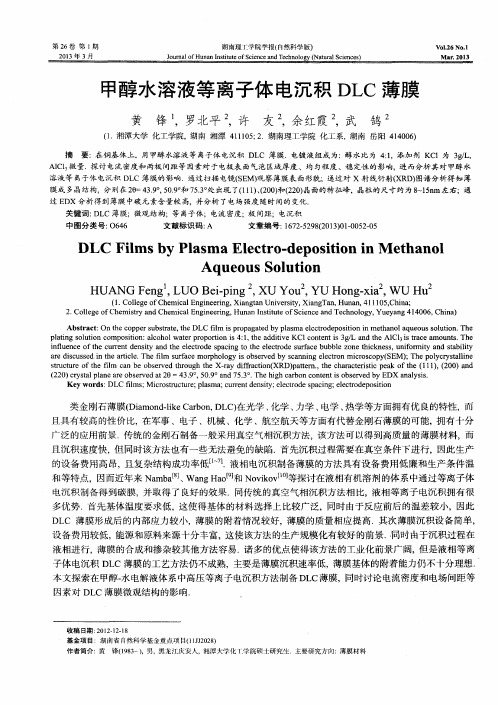
第2 6卷 第 1 期
2 0 1 3 年 3 月
湖南理 I : 学院学 报( 自然 科学 版)
J o u r n a l o f H u n a n I n s t i t u t e o f S c i e n c e a n d T e c h n o l o g y( Na t u r a 1 S c i e n c e s )
溶液等 离子体电沉积 D L C薄膜的影 响. 通过扫描 电镜( s E M) 观 察薄膜表面形 貌; 通过对 x 射线衍射( x R D 图 谱 分析得知薄
膜成 多晶结构,分别在 2 0 =4 3 9 。 , 5 0 . 9 。 和7 5 . 3 。 处 出现 了( 1 1 1 ) 、 ( 2 0 0 ) 和( 2 2 0 ) 晶面的特征峰,晶粒的尺寸约为 8 - 1 5 n m左右;通
i n l f u e n c e o f t h e c u r r e n t d e n s i y t a n d t h e e l e c t r o d e s p a c i n g t o t h e e l e c t r o d e s u r f a c e b u b b l e z o n e t h i c k n e s s , u n i f o r mi y t a n d s t a b i l i y t
核类美学英语
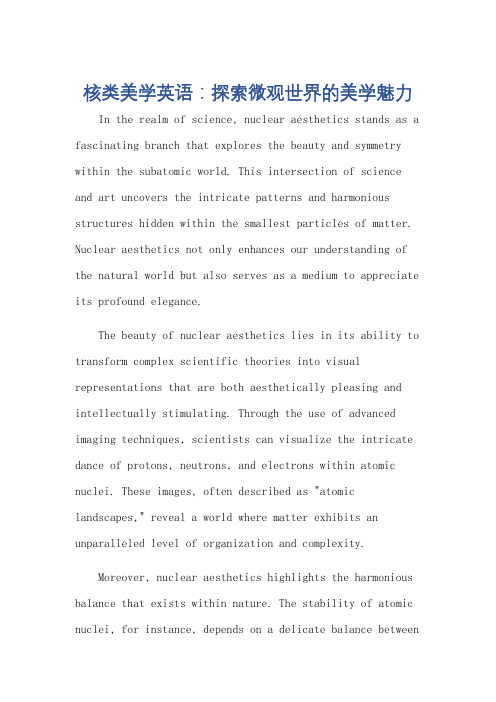
核类美学英语:探索微观世界的美学魅力 In the realm of science, nuclear aesthetics stands as a fascinating branch that explores the beauty and symmetry within the subatomic world. This intersection of science and art uncovers the intricate patterns and harmonious structures hidden within the smallest particles of matter. Nuclear aesthetics not only enhances our understanding of the natural world but also serves as a medium to appreciate its profound elegance.The beauty of nuclear aesthetics lies in its ability to transform complex scientific theories into visual representations that are both aesthetically pleasing and intellectually stimulating. Through the use of advanced imaging techniques, scientists can visualize the intricate dance of protons, neutrons, and electrons within atomic nuclei. These images, often described as "atomic landscapes," reveal a world where matter exhibits an unparalleled level of organization and complexity.Moreover, nuclear aesthetics highlights the harmonious balance that exists within nature. The stability of atomic nuclei, for instance, depends on a delicate balance betweenthe forces of attraction and repulsion acting on its constituent particles. This equilibrium gives rise to a sense of symmetry and harmony that is both visually appealing and intellectually satisfying.The appreciation of nuclear aesthetics also serves as a powerful tool for scientific education. By making the invisible world of atoms and subatomic particles visible and accessible, nuclear aesthetics helps to demystify science and make it more relatable to the general public. This, in turn, fosters a deeper understanding and appreciation for the natural world and the scientific processes that govern it.In conclusion, nuclear aesthetics offers a unique perspective on the beauty and symmetry within the subatomic world. By bridging the gap between science and art, it allows us to appreciate the profound elegance of nature and the intricate patterns that underlie the very fabric of our existence. As we continue to explore the mysteries of the universe, nuclear aesthetics will continue to reveal new horizons of beauty and understanding.**核类美学英语:微观世界的美学探索**在科学的领域中,核类美学作为一门迷人的分支,探索着次原子世界中的美与对称性。
《声子散射下纤锌矿AlGaN多层异质结构中电子的迁移率》范文
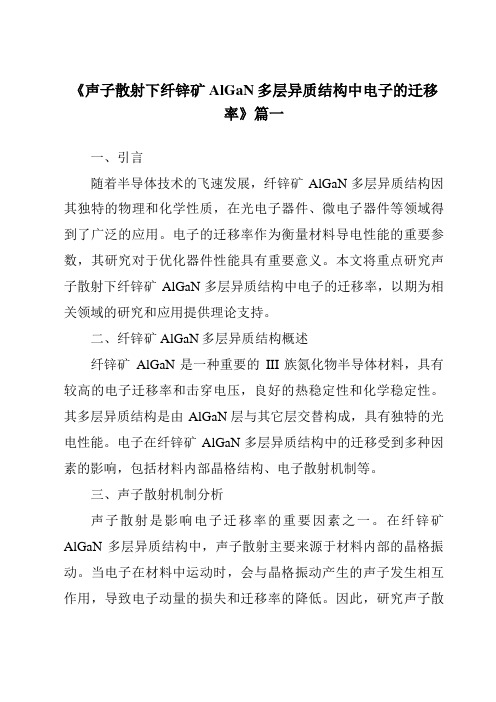
《声子散射下纤锌矿AlGaN多层异质结构中电子的迁移率》篇一一、引言随着半导体技术的飞速发展,纤锌矿AlGaN多层异质结构因其独特的物理和化学性质,在光电子器件、微电子器件等领域得到了广泛的应用。
电子的迁移率作为衡量材料导电性能的重要参数,其研究对于优化器件性能具有重要意义。
本文将重点研究声子散射下纤锌矿AlGaN多层异质结构中电子的迁移率,以期为相关领域的研究和应用提供理论支持。
二、纤锌矿AlGaN多层异质结构概述纤锌矿AlGaN是一种重要的III族氮化物半导体材料,具有较高的电子迁移率和击穿电压,良好的热稳定性和化学稳定性。
其多层异质结构是由AlGaN层与其它层交替构成,具有独特的光电性能。
电子在纤锌矿AlGaN多层异质结构中的迁移受到多种因素的影响,包括材料内部晶格结构、电子散射机制等。
三、声子散射机制分析声子散射是影响电子迁移率的重要因素之一。
在纤锌矿AlGaN多层异质结构中,声子散射主要来源于材料内部的晶格振动。
当电子在材料中运动时,会与晶格振动产生的声子发生相互作用,导致电子动量的损失和迁移率的降低。
因此,研究声子散射机制对于理解电子在纤锌矿AlGaN多层异质结构中的迁移行为具有重要意义。
四、电子迁移率计算与实验验证(一)理论计算本研究采用先进的计算机模拟技术,对纤锌矿AlGaN多层异质结构中电子的迁移率进行理论计算。
通过建立精确的模型,模拟电子在材料中的运动过程和与声子的相互作用,从而得到电子的迁移率。
(二)实验验证为了验证理论计算的准确性,我们开展了相关实验。
通过制备纤锌矿AlGaN多层异质结构样品,并利用霍尔效应等实验手段测量电子的迁移率。
将实验结果与理论计算结果进行对比,验证了理论计算的可靠性。
五、结果与讨论(一)结果概述通过理论计算和实验验证,我们得到了声子散射下纤锌矿AlGaN多层异质结构中电子的迁移率。
结果表明,声子散射对电子迁移率具有显著影响。
在不同温度和不同掺杂浓度下,电子的迁移率表现出不同的变化趋势。
氢冶金相关的英文学术报告
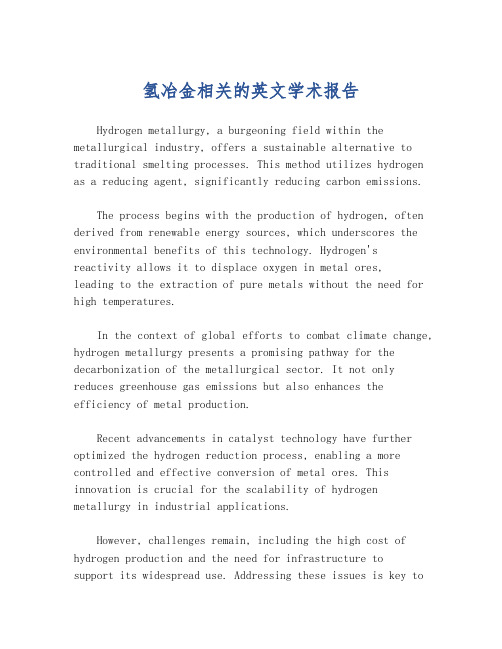
氢冶金相关的英文学术报告Hydrogen metallurgy, a burgeoning field within the metallurgical industry, offers a sustainable alternative to traditional smelting processes. This method utilizes hydrogen as a reducing agent, significantly reducing carbon emissions.The process begins with the production of hydrogen, often derived from renewable energy sources, which underscores the environmental benefits of this technology. Hydrogen'sreactivity allows it to displace oxygen in metal ores,leading to the extraction of pure metals without the need for high temperatures.In the context of global efforts to combat climate change, hydrogen metallurgy presents a promising pathway for the decarbonization of the metallurgical sector. It not only reduces greenhouse gas emissions but also enhances the efficiency of metal production.Recent advancements in catalyst technology have further optimized the hydrogen reduction process, enabling a more controlled and effective conversion of metal ores. This innovation is crucial for the scalability of hydrogen metallurgy in industrial applications.However, challenges remain, including the high cost of hydrogen production and the need for infrastructure tosupport its widespread use. Addressing these issues is key tothe adoption of hydrogen metallurgy on a larger scale.Research is ongoing to explore the potential of hydrogen in various metallurgical processes, including the production of steel, aluminum, and other critical metals. The findings could revolutionize the industry, leading to a more sustainable future.In conclusion, hydrogen metallurgy represents a significant step towards a greener metallurgical industry. With continued research and development, it has the potential to become a cornerstone of the global transition to a low-carbon economy.。
- 1、下载文档前请自行甄别文档内容的完整性,平台不提供额外的编辑、内容补充、找答案等附加服务。
- 2、"仅部分预览"的文档,不可在线预览部分如存在完整性等问题,可反馈申请退款(可完整预览的文档不适用该条件!)。
- 3、如文档侵犯您的权益,请联系客服反馈,我们会尽快为您处理(人工客服工作时间:9:00-18:30)。
a r X i v :0809.4470v 1 [a s t r o -p h ] 25 S e p 2008Draft version September 25,2008Preprint typeset using L A T E X style emulateapj v.10/09/06DEEP MIXING AND METALLICITY:CARBON DEPLETION IN GLOBULAR CLUSTER GIANTSSarah L.Martell and Graeme H.SmithUniversity of California Observatories/Lick ObservatoryDepartment of Astronomy &Astrophysics,UC Santa Cruz and1156High St,Santa Cruz,CA 95064andMichael M.BrileyDepartment of Physics and Astronomy,University of Wisconsin Oshkosh and800Algoma Blvd,Oshkosh,WI 54901Draft version September 25,2008ABSTRACTWe present the results of an observational study of the efficiency of deep mixing in globular cluster red giants as a function of stellar metallicity.We determine [C/Fe]abundances based on low-resolution spectra taken with the Kast spectrograph on the 3m Shane telescope at Lick Observatory.Spectra centered on the 4300˚A CH absorption band were taken for 42bright red giants in 11Galactic globular clusters ranging in metallicity from M92([Fe/H]=−2.29)to NGC 6712([Fe/H]=−1.01).Carbon abundances were derived by comparing values of the CH bandstrength index S 2(CH )measured from the data with values measured from a large grid of SSG synthetic spectra.Present-day abundances are combined with theoretical calculations of the time since the onset of mixing,which is also a function of stellar metallicity,to calculate the carbon depletion rate across our metallicity range.We find that the carbon depletion rate is twice as high at a metallicity of [Fe/H]=−2.3than at [Fe/H]=−1.3,which is a result qualitatively predicted by some theoretical explanations of the deep mixing process.Subject headings:Globular clusters:individual (NGC 4147,NGC 5727,M3,NGC 5904,M5,NGC6205,M13,NGC 6254,M10,NGC 6341,M92,NGC 6535,NGC 6712,NGC 6779,M56,NGC 7078,M15,NGC 7089,M2)-Stars:abundances -Stars:evolution1.INTRODUCTIONThe observation that carbon abundance in globular cluster red giants declines continuously as the stars evolve has inspired a great deal of observational and theoretical study (e.g.,Suntzeff1981,Carbon et al.1982,Trefzger et al.1983,Suntzeff&Smith 1991,Weiss &Charbonnel 2004,Denissenkov &Tout 2000,Smith &Briley 2006,and similar work).Canonically,abundances should be static on the red giant branch after the first dredge-up because of the broad radia-tive zone between the hydrogen-burning shell and the surface.Progressive carbon depletion with rising lu-minosity on the giant branch is commonly interpreted as a sign of a non-convective “deep mixing”process that mixes carbon-depleted material from the hydrogen-burning shell,where the CN(O)cycle is acting,to the surface (e.g.,Sweigart &Mengel 1979,Charbonnel 1995,Charbonnel et al.1998,Bellman et al.2001,Denis-senkov &VandenBerg 2003,and others).This same de-pletion of surface carbon abundance is also observed in red giants in the halo field (e.g.,Gratton et al.2000),and is observed to occur at the same rate in the halo field as in globular clusters with halo-like metallicities (e.g.,Smith &Martell 2003).The process of deep mixing,inferred from observations of low [C/Fe],log ǫ(Li),and 12C/13C,is only observed to occur in stars brighter than the red giant branch (RGB)luminosity function “bump”(Charbonnel et al.1998).There are indications (e.g.,Langer et al.1986,BellmanElectronic address:martell@,graeme@ Electronic address:mike@et al.2001)that there may be carbon depletion in stars fainter than the RGB bump in the metal-poor globu-lar cluster M92,though there is not an obvious physical explanation for such a phenomenon.During the first dredge-up,in the subgiant phase,the base of the convec-tive envelope drops inward to smaller radius as the stellar core contracts,mixing the partially-processed material of the stellar interior with the unprocessed material at the surface.As hydrogen shell burning progresses,low on the giant branch,the temperature gradient in the star steepens and the base of the convective envelope begins to move outward,leaving behind a sharp jump in mean molecular weight (the “µ-barrier”)at the point of its fur-thest inward progress (Iben 1965).As the convective en-velope retreats outward,this steep µgradient finds itself within a radiative region between the hydrogen-burning shell and the base of the convective zone,where it can po-tentially hinder mass motions within the radiative zone.The red giant branch bump is an evolutionary stut-ter that occurs when the hydrogen-burning shell,which is advancing outward in mass,encounters the µbar-rier.The sudden influx of hydrogen-rich material to the hydrogen-burning shell causes the star to become briefly bluer and fainter before it re-equilibrates and continues to evolve along the red giant branch (e.g.,Iben 1968,Cassisi et al.2002).In a collection of stars with equal age and composition,this evolutionary loop will result in an unexpectedly large number of stars at a particu-lar magnitude,and a bump in the differential luminos-ity function.At a fixed mass,the base of the convec-tive envelope sinks lower in higher-metallicity stars dur-ing the first dredge-up,meaning that the RGB bump2occurs at a fainter luminosity on the RGB in high-metallicity globular clusters than in low-metallicity clus-ters(e.g.,Zoccali1999).However,because evolutionary timescales shorten as stellar mass rises,there is a max-imum mass of≃2M⊙for stars to experience this evo-lutionary loop:above that mass,the hydrogen-burning shell does not move outward far enough to cross theµbarrier in the short time the star is on the RGB(Gilroy 1989).The fact that deep mixing does not begin un-til after the hydrogen-burning shell crosses theµbar-rier is interpreted by,e.g.,Charbonnel(1994)to mean that the gradient of mean molecular weight is the domi-nant factor in permitting or prohibiting deep mixing.In-deed,Denissenkov&VandenBerg(2003)point out that ∇µis“the only physical quantity that changes signif-icantly while approaching the hydrogen-burning shell”in post-bump red giants.Chanam´e et al.(2005)pro-vide a somewhat different perspective:in their maximal-mixing models,theµgradient inhibits mixing on the upper giant branch,but rotational mixing processes are not strong enough on the lower giant branch to cause observable changes in surface abundances,regardless of whether there is a steepµgradient present.The underlying physical reason for deep mixing is not clear,though rotation has commonly been implicated since Sweigart&Mengel(1979)proposed meridional cir-culation as an explanation for CNO anomalies in red giants.Recent theoretical studies tend to focus on spe-cific parametrizations and representations of the process; for example,Rayleigh-Taylor instability(Eggleton et al. 2008),diffusion(Denissenkov&VandenBerg2003), and thermohaline mixing(Charbonnel&Zahn2007). Palacios et al.(2006)demonstrated that meridional cir-culation,differential rotation,and shear turbulence do not create enough mixing to account for the observed variations in surface abundances,implying that addi-tional hydrodynamical processes must be acting.The large study of surface abundances infield giants pub-lished by Gratton et al.(2000)is a key to differentiating between models of deep mixing,since it demonstrates clearly the progressive depletion of carbon on the giant branch,as well as the sharp drop in12C/13C and logǫ(Li) that happens at the RGB bump.The fundamental result from Gratton et al.(2000) that all current deep mixing models must reproduce is that deep mixing is universal among post-bump red gi-ants.Charbonnel et al.(1998)consider mixing in terms of the“criticalµgradient,”the largest gradient in mean molecular weight that still permits deep mixing.In an observational study of seven mildly metal-poor red gi-ants in the region of the RGB bump,theyfind that the criticalµgradient is independent of composition or mass. Denissenkov&VandenBerg(2003)use the formalism of diffusion,with mixing depth and a diffusion con-stant as the important parameters,to model deep mix-ing.Theyfind that the mixing depth does not depend strongly on metallicity,which implies that all red giants with a mass less than≃2M⊙will experience deep mix-ing.Theirfigures also show that the evolution of surface abundances of carbon and nitrogen are not particularly affected by metallicity,though reductions in logǫ(Li)and 12C/13C are more sensitive.Eggleton et al.(2008)show that the reaction3He(3He,2p)4He causes aµ-inversion in the outer edge of the hydrogen-burning shell,and claim that the resulting Rayleigh-Taylor instability is impor-tant in driving deep mixing.Charbonnel&Zahn(2007) argue that the more complex process of thermohaline convection will act in thatµ-inversion region.They use the Ulrich(1972)prescription to parametrize the ther-mohaline mixing as a diffusion process.In contrast to Denissenkov&VandenBerg(2003),theyfind that the evolution of the surface abundances of carbon,nitrogen, and lithium are all affected by overall stellar metallicity, while the12C/13C ratio approaches its equilibrium value very quickly at all metallicities.Although questions of deep mixing rate(e.g.,Smith& Martell2003)and depth(e.g.,Charbonnel et al.1998) have been studied observationally by many authors,the results available in the literature can be difficult to syn-thesize into a single conclusion.Many studies focus on one or two particular clusters(e.g.,Da Costa&Cot-trell1980,Suntzeff1981,Trefzger et al.1983,Lee 1999),or attempt to correlate deep mixing with other cluster properties such as horizontal branch morphol-ogy(Cavallo&Nagar2000),stellar rotational velocity (Chanam´e et al.2005)or cluster ellipticity(Norris1987). Individual authors and collaborations develop their own analysis tools,and the differences between spectral in-dex definitions,model atmospheres,spectral synthesis engines,and abundance determination methods produce significant systematic differences in different authors’abundance scales,as is clear from literature-compilation studies such as Smith(2002).One can construct a phenomenological picture of deep mixing from this heterogeneous information,and it goes roughly as follows:all stars with mass less than≃2M⊙will at some point have their hydrogen-burning shell cross theµ-barrier.Theµ-barrier is larger than the criti-calµ-gradient for deep mixing,so its destruction per-mits deep mixing to begin.Deep mixing occurs con-tinuously,and involves all material outside the radius where theµ-gradient within the outer H-burning shell is critical.The onset of deep mixing happens lower on the giant branch for higher-metallicity clusters,because theirµ-barrier is at smaller radius.However,in higher-metallicity stars the hydrogen-burning shell is more com-pact(Sweigart&Mengel1979),so that the radius where theµ-gradient is critical is relatively further out in the hydrogen-burning shell.This means that the material mixed to the surface in higher-metallicity stars is less processed than in low-metallicity stars.Various authors (e.g.,Charbonnel et al.1998,Cassisi et al.2002)use this relation between metallicity and mixing efficiency to study the structure of the hydrogen-burning shell.Our goal in this project is to determine the relative efficiency of deep mixing across a broad range of metal-licity by measuring present-day carbon abundances and depletion rates from a homogeneous set of globular clus-ter red giants in similar evolutionary phases.An earlier example of this approach is the study of Bell&Dickens (1980),who found that[C/Fe]on the upper RGB of M3, M13and NGC6752correlated with[Fe/H]metallicity.2.THE DATA SETIn order to construct a data set that could be used to compare CH bandstrengths and[C/Fe]abundances across a wide range of metallicity,we chose to obtain our data exclusively with the Kast double spectrograph3 Fig.1.—Selected spectra from our data set.M V≃−1.5for allstars,[Fe/H]varies from−2.25(M15K77)to−1.01(NGC6712LM11)in roughly equal steps.The vertical bars with widely spacedshading mark the bandpasses for the comparison bands of S2(CH),and the narrowly spaced shading marks the corresponding scienceband.on the Shane3m telescope at Lick Observatory,devot-ing21nights between July2004and August2006to thedata ing a mirror in place of a dichroic,we directed all light to the blue side of the spectro-graph,where the600/4310(moderate-resolution)grismproduced a pixel spacing of≃1.8˚A/pix and a resolu-tion of approximately5.4˚A over a wavelength range of3400to5400˚A.The detector at the time was a thinned1200×400-pixel Reticon CCD.Table1lists names,po-sitions,distance moduli,reddenings,metallicities,andnumber of stars observed for each globular cluster in-cluded in the survey.Metallicities,distance moduli andreddenings were all taken from the February2003revi-sion of the online compilation of Harris(1996).Photom-etry for the individual globular clusters was taken froma combination of original photographic color-magnitudediagram work and proper-motion membership studies:Sandage&Walker(1955)for NGC4147,Sandage(1953)and Cudworth(1979b)for M3,Arp(1955)and Cudworth(1979c)for M5,Arp(1955)and Cudworth(1979a)for M13,Arp(1955)and Harris et al.(1976)for M10,Cudworth(1976b)for M92,Cudworth(1976a)for M15,Liller(1980)for NGC6535,Sandage&Smith(1966)andCudworth(1988)for NGC6712,Barbon(1965)for M56,and Harris(1975)and Cudworth&Rauscher(1987)forM2.Targets were observed with a slit width of1′′,1.5′′,or2′′depending on the seeing.Ideally,three consecutiveexposures of each star were taken,with typical exposuretimes of1800s,to allow for cosmic ray removal.For17ofthe42stars in our sample,there was only time to obtainone or two exposures on a particular night:four of themwere observed again at a later date,nine have only twoexposures,and four have only one exposure.In all cases,the various exposures were reduced independently,andspectra of each individual star were coadded to produce afinal(unfluxed)1-d spectrum.The standard stars Feige34,Feige110,BD+284211,and BD+332642wereobserved with a9′′slit aligned with the parallactic anglein an effort to capture maximal UVflux for reliablefluxcalibrations.Since Kast sits at Cassegrain focus,spectraof the HeHgCd lamp were taken directly following targetspectra,with the same telescope pointing,slit width anddispersive element,to facilitate wavelength calibrationand account forflexure.Data reduction was accomplished with the XIDLLowRedux package made available by J.X.Prochaska atUC Santa Cruz1.This comprehensive,updated versionof the XIDL code used in earlier form in Martell et al.(2008b)handles bias subtraction,flat-fielding,cosmic rayremoval,object identification and extraction,sky sub-traction,flexure correction,wavelength calibration,at-mospheric correction,coadding andflux calibration.Our targets are bright red giants in the range−1.0≥M V≥−2.0,which generally required3600-second expo-sures with Kast to obtain signal-to-noise ratios per pixeljust redward of the G band of roughly150.These starsare all significantly brighter than the RGB luminosityfunction bump,meaning that any reasonable deep mix-ing rate will have had time to make a measurable decre-ment in surface carbon abundance.Figure1shows se-lected spectra from our sample,with metallicities rangingfrom[Fe/H]=−2.29(lowest spectrum)to[Fe/H]=−1.01(highest spectrum)in roughly equal steps.As[Fe/H]rises,there is a clear increase in the strength of the Mgb and MgH features near5170˚A,a slight increase in thestrength of the broad CN absorption feature at4215˚A,and a reddening of the overall continuum shape that re-duces the apparent depth of the Ca II H&K lines at3935and3970˚A and the CN bandhead at3883˚A.3.ANALYSISWe use the index S2(CH),recently defined inMartell et al.(2008a)to be sensitive to carbon abun-dance and relatively independent of nitrogen abundanceover a wide range of metallicity,to quantify the strengthof the CH G band in all of our combined,flux-calibratedspectra.As with most spectroscopic indices,S2(CH)ismeasured as the magnitude difference between the inte-gratedflux in the relevant absorption feature(the“sci-ence band”)and the integratedflux in two nearby rela-tively absorption-free bands(the“comparison bands”).As discussed in Martell et al.(2008a),the science bandfor S2(CH)runs from4297˚A to4317˚A,and the compari-son bands run from4212˚A to4242˚A and4330˚A to4375˚A.The bandpasses for S2(CH)are shown as shaded regionsin Figure1,with the more widely spaced lines markingthe comparison bands,and the more closely spaced shad-ing lines marking the science band.One-sigma errors on measured values of S2(CH)weredetermined as in Martell et al.(2008b):for stars ob-served three or more times,σS is calculated as the stan-dard deviation on the mean of the individual index val-ues measured fromflux-calibrated,uncombined spectra,and for stars observed twice,σS=0.89×∆S2(CH)2.Starsobserved only once are assumed to have errors in theirS2(CH)values equal to the mean value ofσS,which is0.0047.To convert bandstrengths to[C/Fe]abundances,wefollow a method similar to that described in Martell et al.(2008b),matching measured values of S2(CH)to valuesderived from synthetic spectra interpolated to match thedata in M V and[Fe/H](the“model grid”).We select the1available from /˜xavier/LowRedux/4Fig. 2.—Error in calculated[C/Fe]abundance resulting from error in the measured index S2(CH),for each star in our sample. The abundance errorσ[C/Fe]is never larger than0.12dex,and isalmost always smaller than0.05dex.subset of the model grid with a canonical[N/Fe]value of+0.6and interpolate between model S2(CH)values tofind a preliminary[C/Fe].We then interpolate the model grid to that preliminary[C/Fe]value,allow[N/Fe] to have its full range of possible values,and interpo-latebetween model values of the CN bandstrength index S(3839)(Norris et al.1981)to calculate a preliminary [N/Fe]abundance.If that preliminary[N/Fe]is more than0.1dex lower or higher than the canonical value, we interpolate the model grid to match it and repeat the S2(CH)-matching process to obtain afinal[C/Fe] abundance.As a check,we also re-calculate[N/Fe]us-ing thefinal[C/Fe]value,and wefind that the differ-ence between preliminary andfinal[C/Fe]and[N/Fe]is never large.This is due in large part to the nitrogen-insensitivity of S2(CH):for afixed[C/Fe],[Fe/H]and T eff,varying[N/Fe]by large amounts does not change S2(CH)significantly.The synthetic spectra employed are quite similar to those used in Martell et al.(2008b):values for T effand log g were taken from12-Gyr Yale-Yonsei (Demarque et al.2004)isochrones calculated for each cluster metallicity,and MARCS model atmospheres (Gustafsson et al.1975)and the SSG spectral synthe-sis program(Bell,Paltoglou,&Trippico1994and refer-ences therein)were used to generate synthetic spectra. For each individual globular cluster metallicity,[C/Fe] varies from−1.4to+0.4in steps of0.2dex,and[N/Fe] varies from−0.6to+2.0in steps of0.2dex.As in Martell et al.(2008b),other variables such as12C/13C, [O/Fe],and v turb were chosen to be consistent with the values used in Briley&Cohen(2001).Synthetic spectra were smoothed to a resolution of5.4˚A and a pixel spacing of1.8˚A to match the data.The errors on our[C/Fe]determinations have several sources,some of which are readily quantifiable:the er-rors in the measured values of S2(CH)are generally quite small,and propagate into small noise-based[C/Fe]er-rors.We determine these noise-based[C/Fe]errors for each star in our sample as half the difference between [C/Fe]calculated for S2(CH)+σS and[C/Fe]calculated for S2(CH)−σS.As can be seen in Figure2,these errors are generally smaller than0.05dex,and are all smallerFig.3.—Method-based error∆[C/Fe]as a function of[Fe/H],for synthetic spectra with−2.31≤[Fe/H]≤−0.83,−1.0≤[C/Fe]≤0.0, 0.0≤[N/Fe]≤1.0,and2%Poisson noise.Method-based errors for individual stars in our sample were assigned as the RMS of all points in thisfigure within±0.05of the[Fe/H]abundance of the parent cluster.Figure adapted from Martell et al.(2008a).than0.12dex.They are also comparable in magnitude to the errors introduced by our index-matching method(the “method-based error”).We calculate a method-based er-ror by choosing a random([Fe/H],[C/Fe],[N/Fe])point within the abundance range spanned by our model grid, interpolating tofind the S2(CH)value that corresponds, and using that value to re-calculate[C/Fe]assuming a canonical[N/Fe]value of+0.6.The difference between the original input value of[C/Fe]and the calculated value is the method-based error.It is discussed more thor-oughly in Martell et al.(2008a),and is a complex func-tion of all of the input abundances.Figure3,which is adapted from Martell et al.(2008a),shows model-based error for a set of synthetic spectra with2%Poisson-distributed noise and abundances in the range typically inhabited by globular cluster stars(−2.31≤[Fe/H]≤−0.83,−1.0≤[C/Fe]≤0.0,0.0≤[N/Fe]≤1.0),as a function of[Fe/H].The addition of noise to the syn-thetic spectra was done to make them resemble the ob-served spectra they are compared to,so that the calcu-lated method-based error would be an accurate repre-sentation of the actual error introduced by our carbon-determination method.We assign a method-based error for a given star in our survey as the RMS of all points in Figure3that fall within±0.05dex of the[Fe/H]metal-licity of its parent cluster.We combine the noise-based error and the method-based error on calculated[C/Fe]in quadrature,since they are independent,andfind that the combined er-rorσC never exceeds0.12dex,and is usually under0.05 dex.Table2lists cluster name,star name,date observed, cluster[Fe/H],M V,S2(CH),σS,[C/Fe],andσC for each star in our sample.It should be noted that we do not include possible errors in our adopted values of[Fe/H]or the corresponding T effand log(g)values taken from the Demarque et al.(2004)isochrones inσC.The matter of systematic offsets to our abundance scale resulting from ourflux calibration,temperature scale,or choice of model atmosphere is not as straightforward to assess.We compiled Figure4to explore the relationship between[C/Fe]values calculated by using a number of different G-band indices defined in the literature.Each5Fig. 4.—Comparison of [C/Fe]values calculated from various CH bandstrength indices,for six of the eleven clusters in our sam-ple.There is generally a vertical offset between abundances derived from the various indices,which may be indicative of errors in flux calibration.vertical column of pointsrepresents one star,with [C/Fe]calculated from the indices s CH (Briley &Smith 1993),m CH (Smith et al.1996),and CH (G )(Lee 1999)(which were created for studies of red giants in the moderate-metallicity globular clusters M13,M3,and M5)plotted as stars,triangles,and squares,respectively.Crosses and diamonds,respectively,represent [C/Fe]calculated from the indices S (CH )(Martell et al.2008b)and S (4243)(Briley et al.1990),which were designed to be used with red giants in the low-metallicity globular clusters M53,M55and NGC 6397.The comparison and science band-passes of these indices are given in Table 3.To deter-mine these alternate [C/Fe]values,we followed an index-matching process identical to the one we used to calculate [C/Fe]from S 2(CH ).Interestingly,in Figure 4,there tend to be consistent vertical offsets between [C/Fe]values from the various indices.Since each index covers slightly different wave-length regions,we interpret this to mean that each one captures different information from the spectrum.In general,indices tuned for low-metallicity stars can have wider comparison bands,and do not need to be as care-fully defined as indices for high-metallicity clusters,be-cause there are absorption features that are important to avoid in high-metallicity spectra (for example,the CN banhdead at 4215˚A ).This makes the broader lower-metallicity indices less affected by noise in the observed spectra,but unreliable and often nitrogen-sensitive when used on high-metallicity spectra.In Figure 4,the values for [C/Fe]calculated from s CH are almost always the highest value for any particular star.Since s CH is defined to have only one comparison band,it is the most susceptible of all the indices we mea-sure to errors in flux calibration or temperature scale.To investigate the possible effects of a mismatch between the overall shape of the data and the synthetic spectra,we performed a test on our M13spectra,which have a fairly large range in [C/Fe]calculated from the various indices.For each of the five M13stars in our sample,we adjusted the flux calibration to match the overall spectral shape of an appropriate synthetic spectrum.We fit a parabola to fairly absorption-free regions between 4000˚A and 4500˚AFig. 5.—Results of the flux-adjustment test:vertical scat-ter among [C/Fe]values calculated for M13stars from variousCH-sensitive indices is greatly reduced when the overall shape of the data continuum is matched to the appropriate synthetic spec-trum.The left panel shows [C/Fe]calculated from five G-band indices defined in the literature (y-axis)versus [C/Fe]calculated from S 2(CH )(x-axis)for the five M13stars in our data set.The right panel shows the results of the same measurements made on data adjusted to match the overall shape of abundance-matched synthetic rge circles in the right panel show the [C/Fe]values calculated from S 2(CH )and the non-adjusted data spectra,and lie very close to the dashed line showing 1:1correspondence.in both the data and interpolated-synthetic spectra,and used the ratio of those two curves to adjust the overall shape of the data to match the synthetic spectra.The left panel of Figure 5is the same as the M13panel of Fig-ure 4,and shows the [C/Fe]abundances calculated from the various CH indices.The right panel shows [C/Fe]abundances calculated from the same CH indices,mea-sured from the flux-adjusted spectra,and the vertical scatter is considerably decreased.The large circles in the right panel show the S 2(CH )-derived [C/Fe]values,measured from the original (non-flux-adjusted)spectra,and they fall almost exactly on the dashed line showing 1:1correspondence.We make two conclusions from this exercise:first,that disagreement between [C/Fe]calcu-lated from indices that purport to measure the same un-derlying abundance can be a sign of flux-calibration or temperature-scale errors,and second,that continuum-division is likely preferable to flux-calibration,so that this potential source of error can be avoided altogether.However,the [C/Fe]values calculated from S 2(CH )are barely changed by the flux adjustment.As discussed in Martell et al.(2008a),S 2(CH )was designed specif-ically to be fairly sensitive to carbon abundance and insensitive to nitrogen abundance over a wide range in metallicity.Therefore we feel that our [C/Fe]values are fairly robust,and we choose to use S 2(CH )for carbon determinations in all of our data,rather than building a patchwork of metallicity-tuned indices and correcting for estimated systemic offsets.In addition,since our goal is a differential measurement of [C/Fe]between stars of vary-ing [Fe/H],the absolute zeropoint of our [C/Fe]abun-dance scale is not vital to our result.In Figure 6we plot [C/Fe]derived from our S 2(CH )measurements versus [C/Fe]values taken from the liter-ature,for the eight stars in our sample with published carbon abundances.Carbon abundances in M3and M13were taken from Suntzeff(1981),carbon abundance val-。
